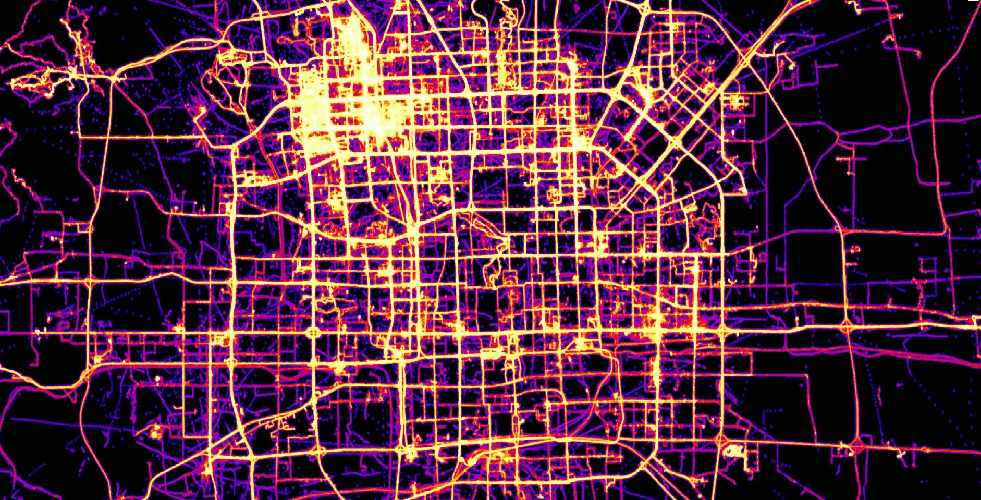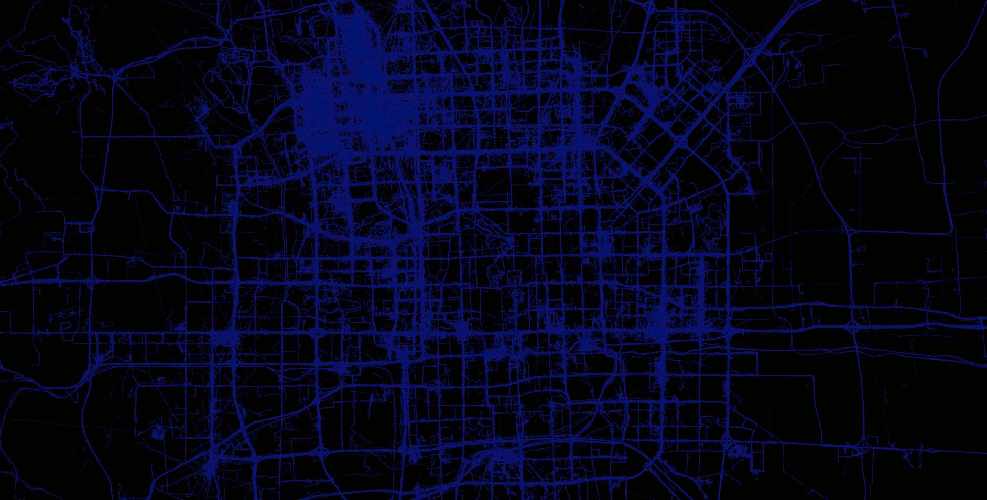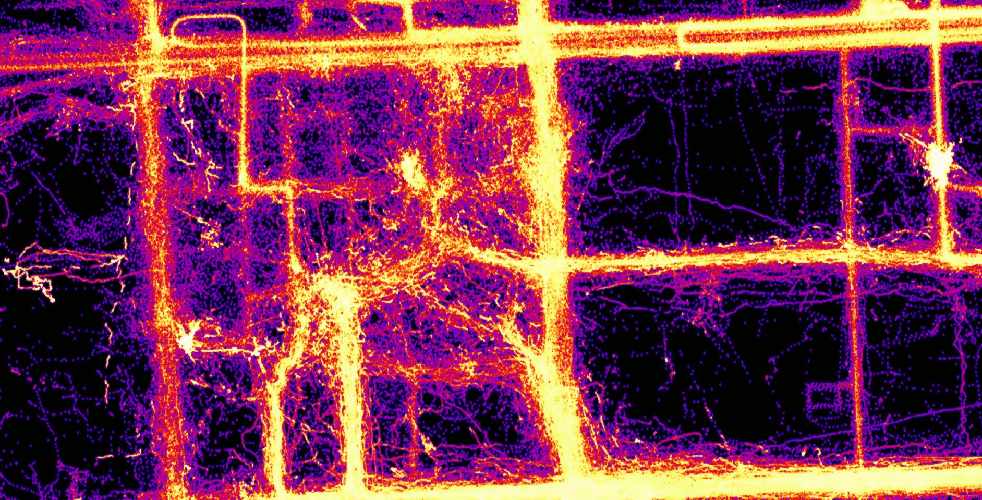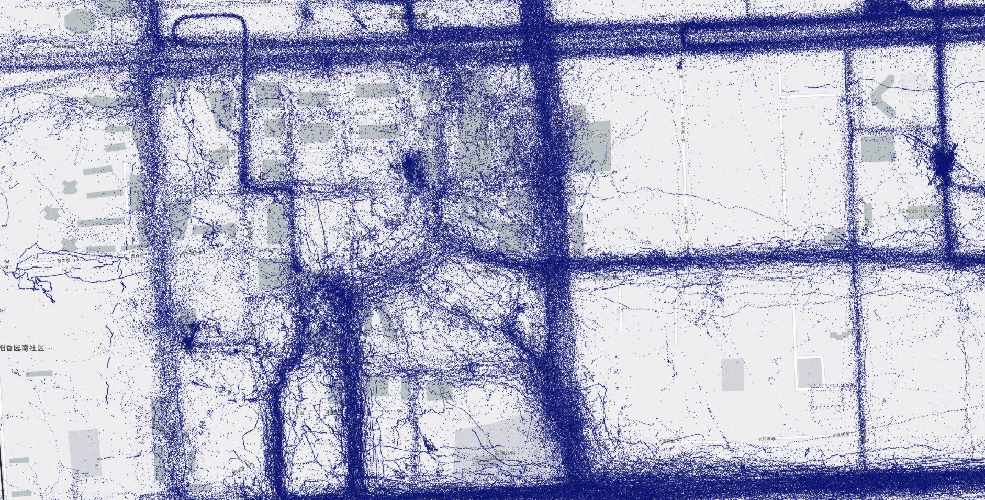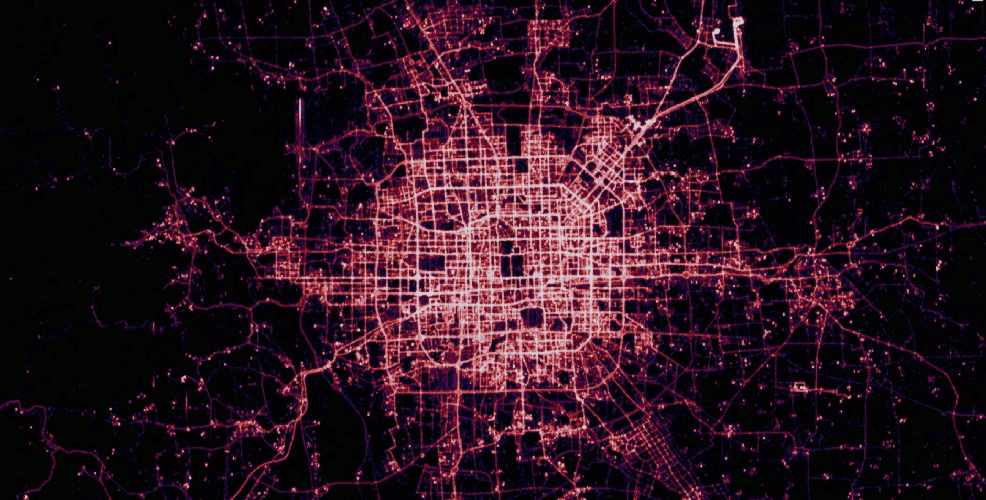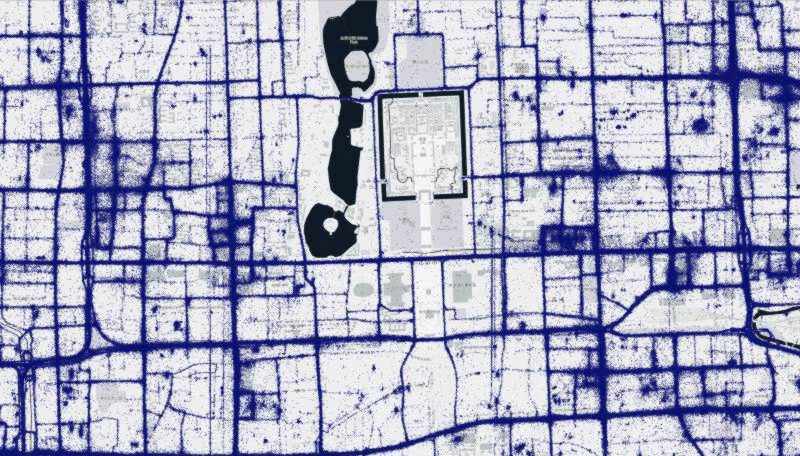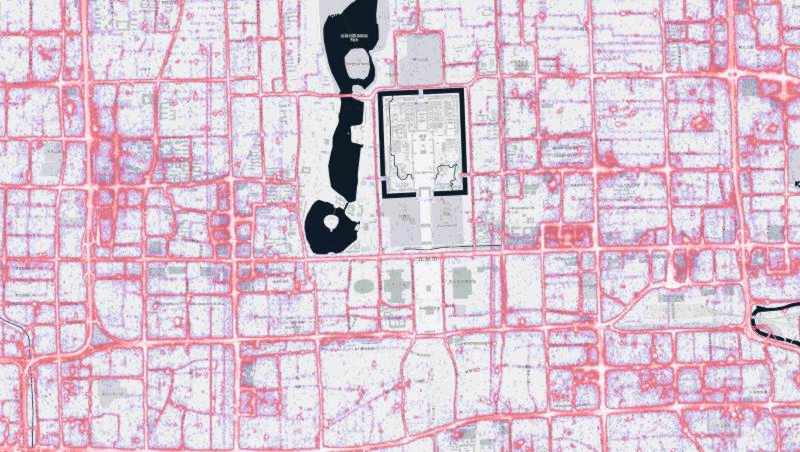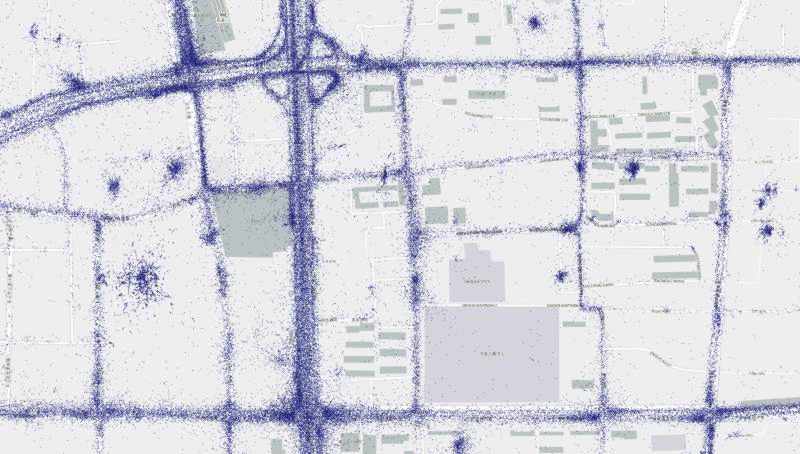What is GeoWave
GeoWave is a library for storage, index, and search of multi-dimensional data on top of a sorted key-value datastore. GeoWave includes specific tailored implementations that have advanced support for OGC spatial types (up to 3 dimensions), and both bounded and unbounded temporal values. Both single and ranged values are supported on all axes. GeoWave’s geospatial support is built on top of the GeoTools extensibility model. This means that it can integrate natively with any GeoTools compatible project (such as GeoServer and UDig), and can ingest GeoTools compatible data sources. GeoWave provides out-of-the-box support for the Apache Accumulo distributed key/value store.
GeoWave Features:
-
Adds multi-dimensional indexing capability to Apache Accumulo
-
Adds support for geographic objects and geospatial operators to Apache Accumulo
-
Provides a GeoServer plugin to allow geospatial data in Accumulo to be shared and visualized via OGC standard services
-
Provides Map-Reduce input and output formats for distributed processing and analysis of geospatial data
GeoWave attempts to do for Accumulo as PostGIS does for PostgreSQL.
Origin
GeoWave was developed at the National Geospatial-Intelligence Agency (NGA) in collaboration with RadiantBlue Technologies and Booz Allen Hamilton. The government has unlimited rights and is releasing this software to increase the impact of government investments by providing developers with the opportunity to take things in new directions. The software use, modification, and distribution rights are stipulated within the Apache 2.0 license.
Intent
Pluggable Backend
GeoWave is intended to be a multidimensional indexing layer that can be added on top of any sorted key-value store. Accumulo was chosen as the initial target architecture. Support for Apache HBase is currently in work, and any datastore which allows prefix based range scans should be straightforward extensions.
Modular Design
The architecture itself is designed to be extremely extensible with most of the functionality units defined by interfaces, and with default implementations of these interfaces to cover most use cases. The intent is that the out of the box functionality should satisfy 90% of use cases but the modular architecture allows for easy feature extension as well as integration into other platforms.
Self-Describing Data
GeoWave stores the information needed to manipulate data (such as configuration and format), in the database itself. This allows software to programmatically interrogate all the data stored in a single or set of GeoWave instances without needing bits of configuration from clients, application servers, or other external stores.
Theory
Spatial Index
GeoWave creates a spatial index to represent multi-dimensional data in a manner that can be reduced to a series of ranges on a 1 dimensional number line. Examples of these include:
-
latitude, longitude
-
latitude, longitude, time
-
latitude, longitude, altitude, time
-
feature vector1, feature vector 2 (…), feature vector n
This is due to the way Accumulo (and any big table based database really) stores the data – as a sorted set of key/value pairs.
The goal is to provide a property that ensures values close in n-dimensional space are still close in 1-dimensional space. There are a few reasons for this, but primarily it’s so we can represent an n-dimensional range selector (bbox typically – but can be abstracted to a hyper-rectangle) as a smaller number of highly contiguous 1d ranges.

Figure: Z-Order curve based dimensional decomposition
Fortunately there is already a type of transform that describes this operation in mathematics – it’s called a “Space Filling Curve” – or SFC for short. Different space filling curves have different properties, but they all take an n-dimensional space and describe a set of steps to trace all points in a single sequence.

Figure: Haverkort, Walderveen Locality and Bounding-Box Quality of Two-Dimensional Space-Filling Curves 2008 arXiv:0806.4787v2
The trade-offs for the various curves are outside the scope of this user manual, but the paper cited for figure two is an excellent starting point to start learning about these curves.
GeoWave has implemented two space filling curves: Z-Order and Hilbert.
Z-Order SFC
This is also commonly called a GeoHash, or Morton order (and sometimes incorrectly called a Peano curve). This is the most popular SFC used for multi-dimensional → 1-dimensional mappings – primarily because it is both intuitive and very easy to implement in code. There are two common ways to implement this. Ideally a bit-interleaving approach is used (that is what gives rise to the diagram in figure 2). Imagine we had two numbers, A and B. Let the binary representation of those numbers be A1A2A3 and B1B2B3. The “bit interleaved” version would be A1B1A2B2A3B3. Since we are working with binary numbers this gives a “unit cell” of 2x2. If we added dimensions, just imagine the same interleaving, but another term - C1C2C3, etc. This is sometimes implemented in base 10 instead of base 2. This implementation reduces somewhat the locality (“packing property” – or the measure of how close numbers in n-dimensional space are to numbers in 1-dimensional space). As you might expect a two dimensional version of this gives a unit cell of 10x10 (for two dimensions) – hence the worse packing.
Hilbert SFC
The Hilbert curve is a bit more complex to work with than the Z-curve – both when calculating and when performing a decomposition – hence it is less commonly used. Nevertheless it is popular in other areas in computer science where multiple variables need to be set in a linear order – process scheduling for one. A simplistic view of a standard projections of the earth mapped to a Hilbert curve would look something like this – with 4 bits of cardinality per dimension (how many buckets we have).
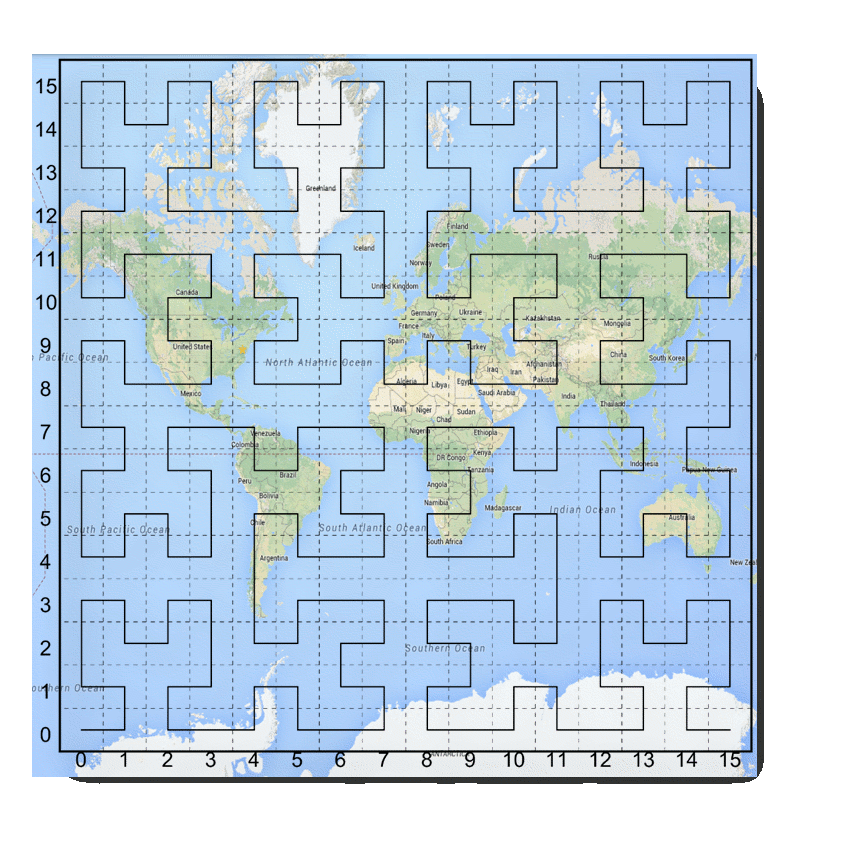
Figure: Hilbert space filling curve superimposed over a projection of the earth
Note that the cardinality (number of buckets per dimensions) has an impact on the resolution of our Hilbert index. Here we map from -180 to +180 over 16 buckets – so we have resolution of no better than 360/16, or 22.5 degrees for longitude (and incidentally 11.25 degrees for latitude). This doesn’t mean we can’t represent values more precisely than this. It just means that our initial (coarse) index (based on SFC ranges) can’t provide resolution any better than this. Adding more bits per dimensions will increase the precision of the SFC based index.
Decomposition
Range decomposition is core to the concept of SFC based indexing. This is when we take a range described in multiple dimensions and turn it into a series of 1d ranges.
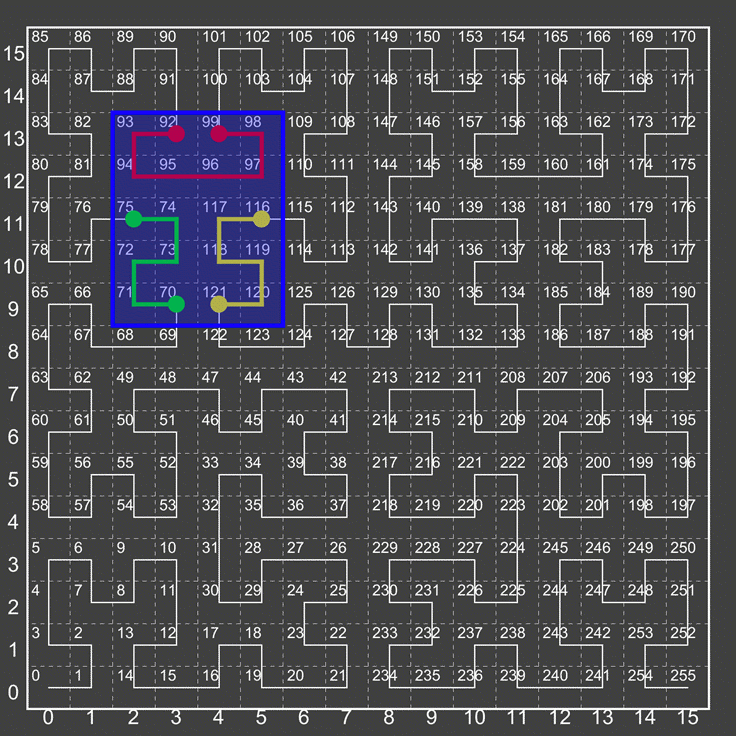
Figure: Hilbert Ranges
In the figure above we show that we mean by this. The bounding box described by the blue selection window – or (2,9) → (5,13) will “fully” decompose to 3 ranges – 70→75, 92→99, and 116→121.
It should be noted that sometimes more simplistic algorithms will not fully decompose – but would instead represent this as 70→121, or even 64→127 (the smallest “unit cell” this box fits in). As you can see, this would result in scanning many extraneous cells.
At some point, with high precision high dimensionality curves, the number of possible unit cells can become too large to deal with. In such a case, GeoWave optimizes this by treating the curve as a “lower cardinality” curve than it actually is. So the unit cell size might not be 1, but instead 64, 128, 1024, etc. This allows the user to still achieve high precision when selection windows are small, but not spend an inordinate amount of time fully decomposing for large selection windows.
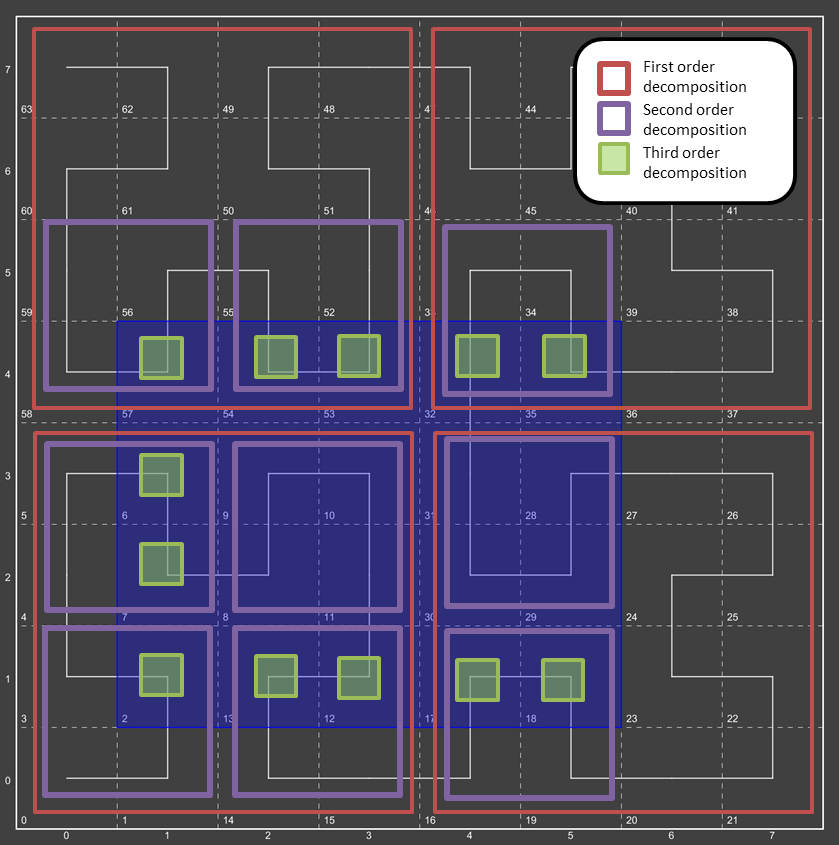
Consider a region query asking for all data from:
(1,1) -> (5,4)
This query range is shown at left by a blue bounding box.
What did we do here?
-
We broke down the initial region into 4 subregions – Red boxes.
-
We broke down each subregion (red box) into 4 sub-sub regions (purple boxes)
-
We then broke down each of those purple boxes into green boxes.
|
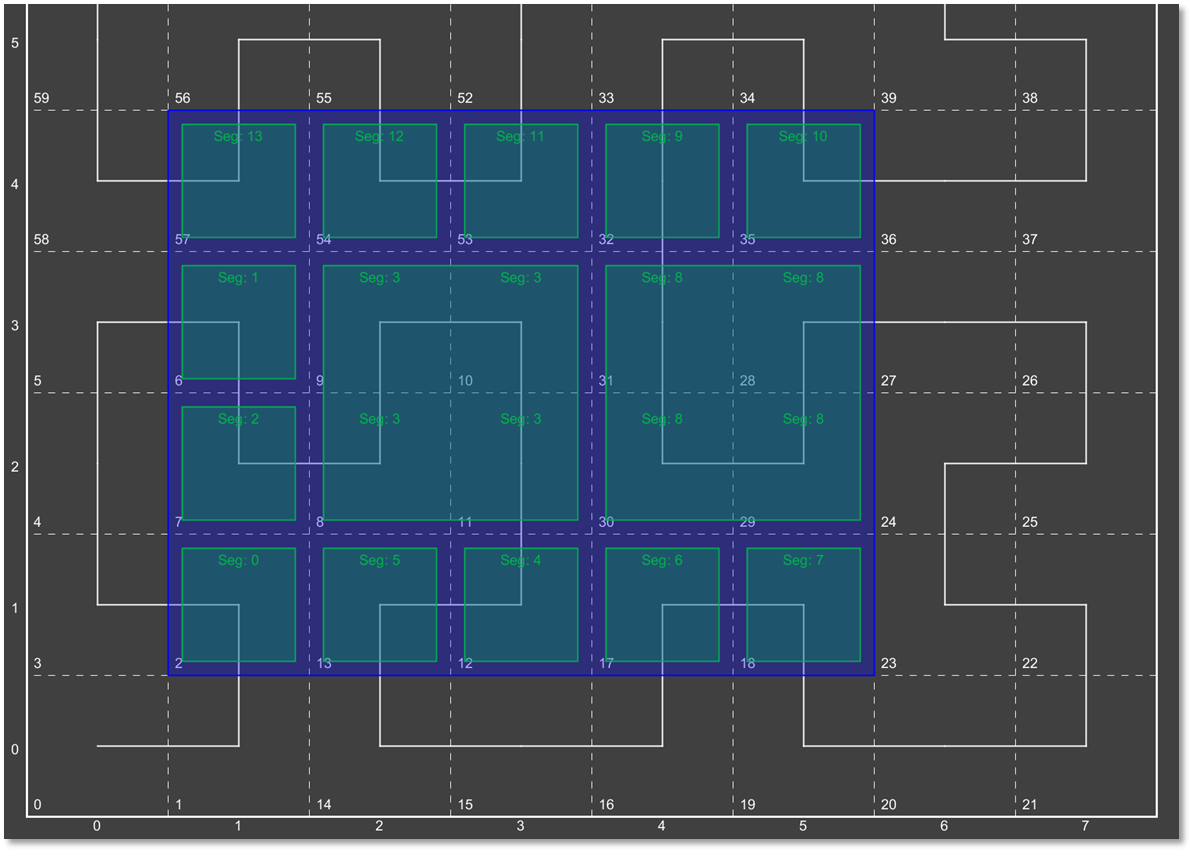
Here we see the query range fully decomposed into the underlying "quads". Note that in some instances we were able to stop decomposing when the query window fully contained the quad (segment 3 and segment 8)

Now we have fully transitioned to the 1d number line from the previous set of quads. We have also rolled together regions which are contiguous.
Example screenshots
The screenshots below are of data loaded from various attributed data sets into a GeoWave instance, processed (in some cases) by a GeoWave analytic process, and rendered by Geoserver.
GeoLife
Microsoft research has made available a trajectory data set that contains the GPS coordinates of 182 users over a three year period (April 2007 to August 2012). There are 17,621 trajectories in this data set.
More information on this data set is available at Microsoft Research GeoLife page
OpenStreetMap GPX Tracks
The OpenStreetMap Foundation has released a large set of user contributed GPS tracks. These are about 8 years of historical tracks. The data set consists of just under 3 billion (not trillion as some websites claim) point, or just under one million trajectories.
More information on this data set is available at GPX Planet page
T-Drive
Microsoft research has made available a trajectory data set that contains the GPS coordinates of 10,357 taxis in Beijing, China and surrounding areas over a one week period. There are approximately 15 million points in this data set.
More information on this data set is available at: Microsoft Research T-drive page
T-drive at city scale
Below are renderings of the t-drive data. They display the raw points along with the results of a GeoWave kernel density analytic. The data corresponds to Mapbox zoom level 12.
Architecture
Overview
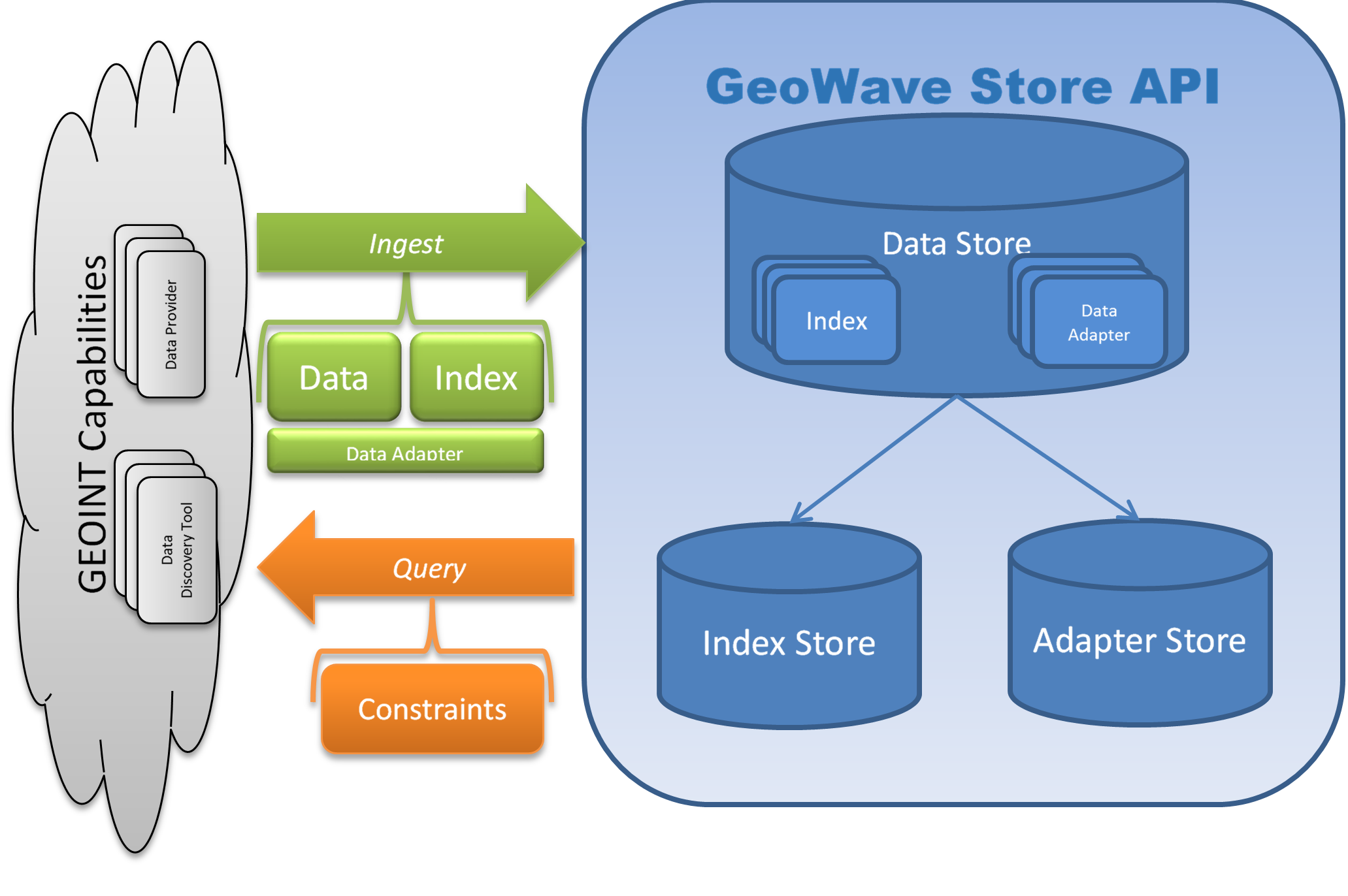
The core of the GeoWave architecture concept is getting data in, and pulling data out – or Ingest and Query. There are also two types of data persisted in the system: feature data, and metadata. Feature data is the actual set of attributes and geometries that are stored for later retrieval. Metadata describes how the data is persisted in the database. The intent is to store the information needed for data discovery and retrieval in the database. This means that an existing data store isn’t tied to a bit of configuration on a particular external server or client, but instead is “self-describing.”
Indexes
The core engine to quickly retrieve data from GeoWave is a SFC (space filling curve) based index. This index can be configured with several different parameters:
-
number of levels
-
number of dimensions
-
cardinality of each dimension
-
dimension type (bounded / unbounded)
-
value range of each dimension
More on each of these properties will be described later; the intent of this list is to provide a notion of what type of configuration information is persisted.
In order to insert data in a datastore the configuration of the index has to be known. The index is persisted in a special table and is referenced back via table name to a table with data in it. Therefore queries can retrieve data without requiring index configuration. There is a restriction that only one index configuration per table is supported - i.e. you can’t store data on both a 2D and 3D index in the same table. (You could store 2D geometry types in a 3D index though).
Adapters
In order to store geometry, attributes, and other information, a format is required that describes how to serialize and deserialize the data. GeoWave provides an interface that handles the serialization and deserialization of feature data. A default implementation supporting the GeoTools simple feature type is included by default. More on this specific implementation, as well as the interface, will be detailed later in this document. A pointer to the java class (expected to be on the classpath) is stored in the Adapter persistence table. This is loaded dynamically when the data is queried and the results are translated to the native data type
Feature Serialization
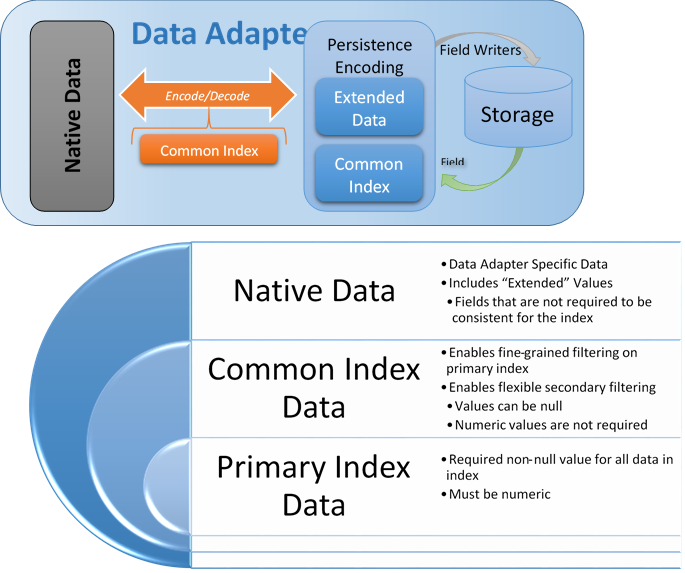
GeoWave allows developers to create their own data adapters. Adapters not only determine how the data is actually stored (serialization/deserialization), but also contain a hierarchy of attribute types. The reason for this hierarchy has to do with extensibility vs. optimization. A data adapter could theoretically take a dependency on ffmpeg, store the feature as metadata in a video stream, and persist that value to the database. All questions of sanity of this solution aside, there are some additional specific issues with the way fine grain filtering is done - specifically due to the iterators. Iterators are part of the Accumulo extensibility module and allow for arbitrary code to be plugged in directly at the tablet server level into the core Accumulo kernel. With more code in the iterators there is both a greater chance of crashing (and taking down a tablet server - and possibly an Accumulo instance), greater use of memory (memory used by the iterator / class loader isn’t available for caching, etc., and a greater O&M debt - the iterators have to be distributed to each client out of band - and require impersonating the Accumulo user (possibly root).
Based on this, our goal was to minimize the code, and standardize on as few iterators as possible. This conflicted with the desire to allow maximum flexibility with arbitrary DataAdapters. A middle ground was found, and this hierarchy was created. Some standardization was put in place around how certain data types would be stored and serialized, but a "native data" portion was still left in place for arbitrary data - with the caveat that native data cannot be used in distributed (iterator based) filtering - only in client side filtering.
Primary Index Data
These are sets of data which are also used to construct the primary index (space filling curve). They will typically be geometry coordinates and optionally time - but could be any set of numeric values (think decomposed feature vectors, etc.). They cannot be null.
Common Index Data
These are a collection of attributes. There can be any number of attributes, but they must conform to the DimensionField interface - the attribute type must have a FieldReader and a FieldWriter that is within the classpath of the tablet servers. GeoWave provides a basic implementation for these attribute types:
-
Boolean
-
Byte
-
Short
-
Float
-
Double
-
BigDecimal
-
Integer
-
Long
-
BigInteger
-
String
-
Geometry
-
Date
-
Calendar
The values that are not part of the primary index can be used for distributed secondary filtering, and can be null. The values that are associated with the primary index will be used for fine-grained filtering within an iterator.
Native Data
These can be literally anything. From the point of view of the data adapter they are just a binary (or Base64) encoded chunk of data. No distributed filtering can be performed on this data except for Accumulo’s visibility filter - but the client side filtering extensibility point can still be used if necessary. The Data Adapter has to provide methods to serialize and deserialize these items in the form of Field Readers and Writers, but it is not necessary to have these methods on the classpath of any Accumulo nodes.
Accumulo Key Structure

The above diagram describes the default structure of entries in the Accumulo data store. The index ID comes directly from the tiered space filling curve implementation. We do not impose a requirement that data IDs are globally unique but they should be unique for the adapter. Therefore, the pairing of Adapter ID and Data ID define a unique identifier for a data element. The lengths are stored within the row ID as 4 byte integers. This enables fully reading the row ID because these IDs can be of variable length. The number of duplicates is stored within the row ID as well to inform the de-duplication filter whether this element needs to be temporarily stored in order to ensure no duplicates are sent to the caller. The adapter ID is within the Row ID to enforce unique row IDs as a whole row iterator is used to aggregate fields for the distributable filters. The adapter ID is also used as the column family as the mechanism for adapter-specific queries to fetch only the appropriate column families.
Statistics
Adapters provide a set of statistics stored within a statistic store. The set of available statistics is specific to each adapter and the set of attributes for those data items managed by the adapter. Statistics include:
-
Ranges over an attribute, including time.
-
Enveloping bounding box over all geometries.
-
Cardinality of the number of stored items.
-
Histograms over the range of values for an attribute.
-
Cardinality of discrete values of an attribute.
Statistics are updated during data ingest and deletion. Range and bounding box statistics reflect the largest range over time. Those statistics are not updated during deletion. Statistics based on cardinality are updated upon deletion.
Statistics retain the same visibility constraints as the associated attributes. Thus, there is a set of statistics for each unique constraint. The statistics store answers each statistics inquiry for a given adapter with only those statistics matching the authorizations of the requester. The statistics store merges authorized statistics covering the same attribute.
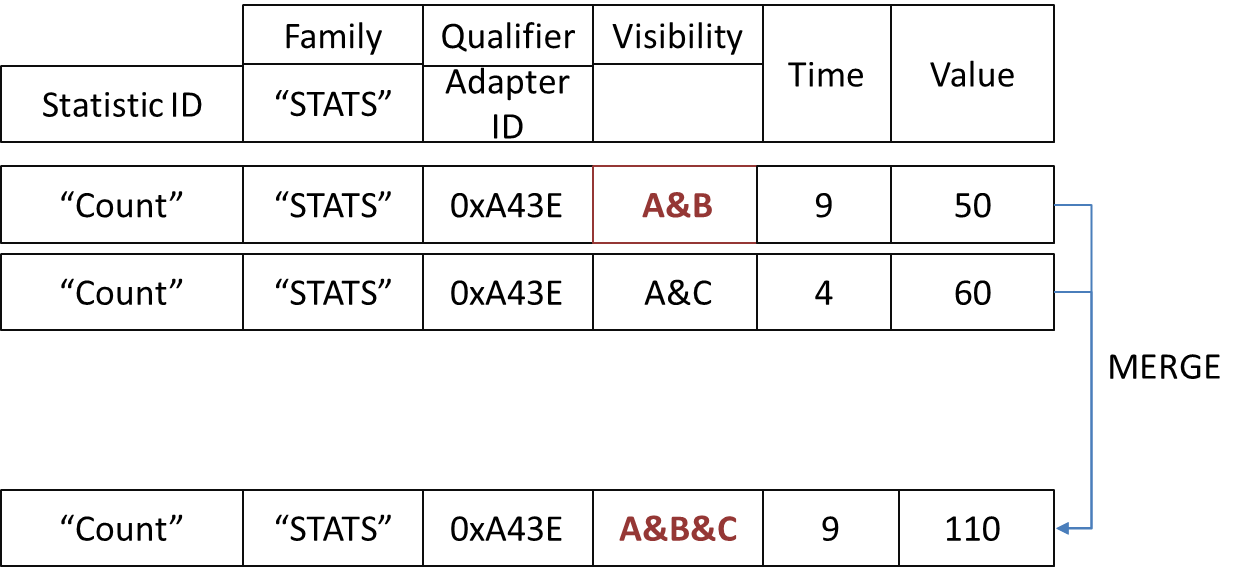
Table Structure in Accumulo

Re-Computation
Re-computation of statistics is required in three circumstances:
-
As indexed items are removed from the adapter store, the range and envelope statistics may lose their accuracy if the removed item contains an attribute that represents the minimum or maximum value for the population.
-
New statistics added to the statistics store after data items are ingested. These new statistics do not reflect the entire population.
-
Software changes invalidate prior stored images of statistics.
\\\\ TODO: figure out why the list above causes formatting issues with the next section \\\\
Tools Framework
A plugin framework (using Service Provider Interface (SPI) based injection) is provided with several input formats and utilities supported out of the box.
First we’ll show how to build and use the built in formats, and after that describe how to create a new plugin.
Building
First build the main project after specifying the dependency versions you’d like to build against.
export BUILD_ARGS="-Daccumulo.version=1.6.0-cdh5.1.4 -Dhadoop.version=2.6.0-cdh5.4.0 -Dgeotools.version=14.2 -Dgeoserver.version=2.8.2 -Dvendor.version=cdh5 -Daccumulo.api=1.6 -P cloudera" (1)
git clone https://github.com/ngageoint/geowave.git (2)
cd geowave
mvn install $BUILD_ARGS (3)| 1 | Examples of current build args can be seen in the top level .travis.yml file in the env/matrix section |
| 2 | If you don’t need the complete history and want to speed up the clone you can limit the depth of your checkout with --depth NUM_COMMITS |
| 3 | You can speed up the build by skipping tests by adding -Dfindbugs.skip=true -DskipFormat=true -DskipITs=true -DskipTests=true |
Now we can build the cli tools framework
mvn package -P geowave-tools-singlejar $BUILD_ARGSThe geowave tools jar is now packaged in deploy/target. When packaged for installation there will be a wrapper script named geowave
that will be installed in $PATH. In a development environment where this script has not been installed you could create a directory
containing the tools jar and any needed plugin jars and use with something like the following command java -cp "$DIR/* <operation> <options>
Config Commands
Commands that affect local configuration only
geowave config addindex
NAME
geowave config addindex - creates an index configuration for use in GeoWave
SYNOPSIS
geowave config addindex [options] <name>
DESCRIPTION
The geowave config addindex operator will create a local index configuration that can be reused but is not associated with a store until data is ingested.
OPTIONS
- -d, --default
-
Make this the default index for creating stores
- -np, --numPartitions <arg>
-
The number of partitions
Default: 1
- -ps, --partitionStrategy <arg>
-
The partition strategy to use
Default: NONE
Possible Values: NONE, HASH, ROUND_ROBIN
- *-t, --type <arg>
-
The type of index, such as spatial or spatial_temporal
Required options: -t, --type
When -t, --type is spatial, the following options are available
--allTiers The index will represent all tiers. Typically for vector data we only need a subset of the tiers to minimize query decomposition, but for raster data typically all tiers is better. Default: false
-d, --default Make this the default index creating stores
-np, --numPartitions The number of partitions. Default partitions will be 1. Default: 1
-ps, --partitionStrategy The partition strategy to use. Default will be none. Default: NONE Possible Values: [NONE, HASH, ROUND_ROBIN]
--pointOnly The index will only be good at handling pointsand will not be optimized for handling lines/polys. The default behavior is to handle any geometry. Default: false
When -t, --type is spatial_temporal, the following options are available
--bias The bias of the spatial-temporal index. There can be more precision given to time or space if necessary. Default: BALANCED Possible Values: [TEMPORAL, BALANCED, SPATIAL]
-d, --default Make this the default index creating stores
-np, --numPartitions The number of partitions. Default partitions will be 1. Default: 1
-ps, --partitionStrategy The partition strategy to use. Default will be none. Default: NONE Possible Values: [NONE, HASH, ROUND_ROBIN]
--period The periodicity of the temporal dimension. Because time is continuous, it is binned at this interval. Default: YEAR Possible Values: [DAY, MONTH, YEAR]
--pointTimestampOnly The index will only be good at handling points and timestamps and will not be optimized for handling lines/polys or time ranges. The default behavior is to handle any geometry and time ranges well. Default: false
geowave config addindexgrp
NAME
geowave config addindexgrp - Group multiple index configurations together given a name SYNOPSIS
geowave config addindexgrp [options] <name> <comma separated list of indexes>
DESCRIPTION
The geowave config addindexgrp operator will group multiple index configurations together given a name. This acts as a convenience for re-using multiple indices together on ingest.
OPTIONS
There are currently no options for this command
geowave config addstore
NAME
geowave config addstore - creates a new store in GeoWave
SYNOPSIS
geowave config addstore [options] <name>
DESCRIPTION
The geowave config addstore operator will create a new store in GeoWave.
OPTIONS
- -d, --default
-
Make this the default store in all operations
- *-t, --type <arg>
-
The type of store, such as accumulo, memory, etc.
Required options: -t, --type
When -t accummulo option is used, additional options are:
--gwNamespace
The geowave namespace (optional; default is no namespace)
-
-i, --instance The Accumulo instance ID
-
-p, --password The password for the user
-
-u, --user A valid Accumulo user ID
-
-z, --zookeeper A comma-separated list of zookeeper servers that an Accumulo instance is using
The following options are required: -u, --user -i, --instance -p, --password -z, --zookeeper
When -t, --type hbase option is used, additional options are:
-d, --default
Make this the default index creating stores
-np, --numPartitions
The number of partitions. Default partitions will be 1.
Default: 1
-ps, --partitionStrategy
The partition strategy to use. Default will be none.
Default: NONE
Possible Values: [NONE, HASH, ROUND_ROBIN]
-t, --type
The type of index, such as spatial, or spatial_temporal
Default: hbase
geowave config cpindex
NAME
geowave config cpindex - copies and modifies an existing index configuration
SYNOPSIS
geowave config cpindex [options] <name> <new name>
DESCRIPTION
The geowave config cpindex operator will copy and modify an existing index configuration. It is possible to override values as you copy, such as cpindex old new --gwNamespace new_namespace.
OPTIONS
- -d, --default
-
Make this the default index creating stores
- -np, numPartitions
-
The number of partitions. Default partitions will be 1. Default: 1
- -ps, --partitionStrategy
-
The partition strategy to use. Default will be none. Default: NONE Possible Values: [NONE, HASH, ROUND ROBIN]
geowave config cpstore
NAME
geowave config cpstore - copies and modifies an existing GeoWave store
SYNOPSIS
geowave config cpstore [options] <name> <new name>
DESCRIPTION
The geowave cpstore operator will copy and modify an existing GeoWave store. It is possible to override values as you copy, such as cpstore old new --gwNamespace new_namespace.
OPTIONS -d, --default::
Makes this the default store in all operations
geowave config list
NAME
geowave config list - will list all properties in local config
SYNOPSIS
geowave config list [options]
DESCRIPTION
The geowave config list operator will list all properties in local config. -f or --filter will allow you to give a regex to filter the list by (useful regexes may be 'store' or 'index' to isolate properties for one or the other or a particular store/index name to further isolate the list).
OPTIONS
- -f or --filter <arg>
-
Filter list by a regex
geowave config rmindex
NAME
geowave config rmindex - removes an index configuration from GeoWave configuration
SYNOPSIS
geowave config rmindex [options] <name>
DESCRIPTION
The geowave config rmindex operator will remove an index configuration from GeoWave configuration
OPTIONS
There are currently no options for this command
geowave config rmindexgrp
NAME
geowave config rmindexgrp - removes an index group from GeoWave configuration
SYNOPSIS
geowave config rmindexgrp [options] <name>
DESCRIPTION
The geowave config rmindexgrp operator will remove an index group from GeoWave configuration
OPTIONS
There are currently no options for this command
geowave config rmstore
NAME
geowave config rmstore - removes an existing store from GeoWave configuration
SYNOPSIS
geowave config rmstore [options] <name>
DESCRIPTION
The geowave config rmstore operator will remove an existing store from GeoWave configuration GeoWave store
OPTIONS
There are currently no options for this command
geowave config set
NAME
geowave config set - will set a valid property name within the cache
SYNOPSIS
geowave config set [options]
DESCRIPTION
The geowave config set operator will set a valid property name within the cache. This can be useful if you want to update a particular property of a index or store.
OPTIONS
There are currently no options for this command
Ingest
Overview
In addition to the raw data to ingest, the ingest process requires an adapter to translate the native data into a format that can be persisted into the data store. Also, the ingest process requires an Index which is a definition of all the configured parameters that define how data is translated to row IDs (how it is indexed) and what common fields need to be maintained within the table to be used by fine-grained and secondary filters.
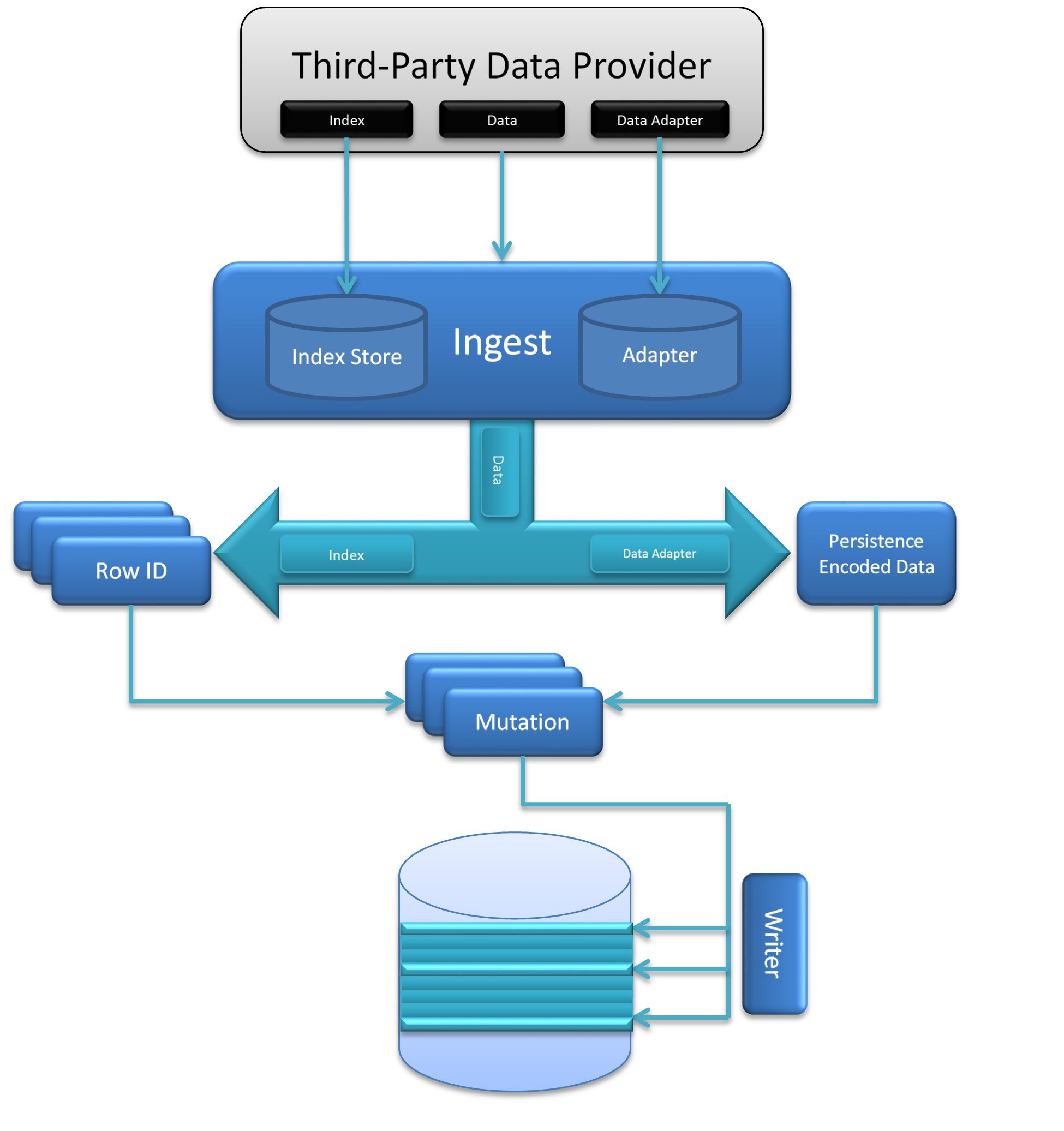
The logic within the ingest process immediately ensures that the index and data adapter are persisted within the Index Store and the Adapter Store to support self-described data discovery. In-memory implementations of both of these stores are provided for cases when connections to Accumulo are undesirable in the ingest process (such as ingesting bulk data in a Map-Reduce job). Then the flow determines the set of row IDs that the data will need to be inserted into. Duplication is essential under certain circumstances and therefore data may be inserted in multiple locations (for example, polygons that cross the dateline, or date ranges that cross binning boundaries such as December 31-January 1 when binning by year). De-duplication is always performed as a client filter when querying the data. This will be combined with the actual data in a persistable format (after a translation has been performed by the adapter) to create a set of mutations.
There is a Writer interface that the data store’s AccumuloOperations will instantiate which specifies how the mutations will actually be written. The default implementation will wrap an Accumulo BatchWriter with this interface, but in some cases it could make sense to provide a custom implementation of the writer. When performing a bulk ingest within the mapper or reducer of a job, it would be appropriate to define a writer to add the mutations to the context of the bulk ingest rather than writing live to Accumulo.
Ingest Commands
Commands that ingest data directly into GeoWave or stage data to be ingested into GeoWave
geowave ingest listformat
NAME
geowave config cpindex - copies and modifies an existing index configuration
SYNOPSIS
geowave config cpindex [options] <name> <new name>
DESCRIPTION
The geowave config cpindex operator will copy and modify an existing index configuration. It is possible to override values as you copy, such as cpindex old new --gwNamespace new_namespace.
OPTIONS
- -d, --default
-
Make this the default index creating stores
- -np, numPartitions
-
The number of partitions. Default partitions will be 1. Default: 1
- -ps, --partitionStrategy
-
The partition strategy to use. Default will be none. Default: NONE Possible Values: [NONE, HASH, ROUND ROBIN]
geowave ingest localToGW
NAME
geowave ingest localToGW - Ingest supported files in local file system directly, without using HDFS
SYNOPSIS
geowave ingest localToGW [options] <file or directory> <storename> <comma delimited index/group list>
DESCRIPTION
The geowave ingest localToGW operator will run the ingest code (parse to features, load features to geowave) against local file system content.
OPTIONS
- -x, --extension
-
individual or comma-delimited set of file extensions to accept (optional)
- -f, --formats
-
Explicitly set the ingest formats by name (or multiple comma-delimited formats), if not set all available ingest formats will be used
- -t, --threads
-
number of threads to use for ingest, default to 1 (optional) Default: 1
- -v, --visibility
-
The visibility of the data ingested (optional; default is 'public')
geowave ingest localToMrGW
NAME
geowave ingest localToMrGW - Copy supported files from local file system to HDFS and ingest from HDFS
SYNOPSIS
geowave ingest localToMrGW [options] <file or directory> <hdfs host:port> <path to base directory to write to> <store name> <comma delimited index/group list>
DESCRIPTION
The geowave ingest localToMrGW operator will Copy supported files from local file system to HDFS and ingest from HDFS
OPTIONS
- -x, --extension
-
individual or comma-delimited set of file extensions to accept (optional)
- -f, --formats
-
Explicitly set the ingest formats by name (or multiple comma-delimited formats), if not set all available ingest formats will be used
- --jobtracker
-
Hadoop job tracker hostname and port in the format hostname:port
- --resourceman
-
Yarn resource manager hostname and port in the format hostname:port
- -v, --visibility
-
The visibility of the data ingested (optional; default is 'public')
geowave ingest localToHdfs
NAME
geowave ingest localToHdfs - Stage supported files in local file system to HDFS
SYNOPSIS
geowave ingest localToHdfs [options] <file or directory> <hdfs host:port> <path to base directory to write to>
DESCRIPTION
The geowave ingest localToHdfs operator will stage supported files in the local file system to HDFS
OPTIONS
- -x, --extension
-
individual or comma-delimited set of file extensions to accept (optional)
- -f, --formats
-
Explicitly set the ingest formats by name (or multiple comma-delimited formats), if not set all available ingest formats will be used
geowave ingest localToKafka
NAME
geowave ingest localToKafka - Stage supported files in local file system to a Kafka topic
SYNOPSIS
geowave ingest localToKafka [options] <file or directory>
DESCRIPTION
The geowave ingest localToKafka operator will stage supported files in the local file system to a Kafka topic
OPTIONS
- -x, --extension
-
individual or comma-delimited set of file extensions to accept (optional)
- -f, --formats
-
Explicitly set the ingest formats by name (or multiple comma-delimited formats), if not set all available ingest formats will be used
- * --kafkaprops
-
Properties file containing Kafka properties
- --metadataBrokerList
-
This is for bootstrapping and the producer will only use it for getting metadata (topics, partitions and replicas). The socket connections for sending the actual data will be established based on the broker information returned in the metadata. The format is host1:port1,host2:port2, and the list can be a subset of brokers or a VIP pointing to a subset of brokers.
- --producerType
-
This parameter specifies whether the messages are sent asynchronously in a background thread. Valid values are (1) async for asynchronous send and (2) sync for synchronous send. By setting the producer to async we allow batching together of requests (which is great for throughput) but open the possibility of a failure of the client machine dropping unsent data.
- --requestRequiredAcks
-
This value controls when a produce request is considered completed. Specifically, how many other brokers must have committed the data to their log and acknowledged this to the leader?
- --retryBackoffMs
-
The amount of time to wait before attempting to retry a failed produce request to a given topic partition. This avoids repeated sending-and-failing in a tight loop.
- --serializerClass
-
The serializer class for messages. The default encoder takes a byte[] and returns the same byte[].
geowave ingest kafkaToGW
NAME
geowave ingest kafkaToGW - Subscribe to a Kafka topic and ingest into GeoWave
SYNOPSIS
geowave ingest kafkaToGW [options] <store name> <comma delimited index/group list>
DESCRIPTION
The geowave ingest kafkaToGW operator will ingest supported files that already exist in HDFS
OPTIONS
- --autoOffsetReset
-
What to do when there is no initial offset in ZooKeeper or if an offset is out of range:
-
smallest : automatically reset the offset to the smallest offset
-
largest : automatically reset the offset to the largest offset
-
anything else: throw exception to the consumer
-
- --batchSize
-
The data will automatically flush after this number of entries Default: 10000
- --consumerTimeoutMs
-
By default, this value is -1 and a consumer blocks indefinitely if no new message is available for consumption. By setting the value to a positive integer, a timeout exception is thrown to the consumer if no message is available for consumption after the specified timeout value.
- -x, --extension
-
individual or comma-delimited set of file extensions to accept (optional)
- --fetchMessageMaxBytes
-
The number of bytes of messages to attempt to fetch for each topic-partition in each fetch request. These bytes will be read into memory for each partition, so this helps control the memory used by the consumer. The fetch request size must be at least as large as the maximum message size the server allows or else it is possible for the producer to send messages larger than the consumer can fetch.
- -f, --formats
-
Explicitly set the ingest formats by name (or multiple comma-delimited formats), if not set all available ingest formats will be used
- --groupId
-
A string that uniquely identifies the group of consumer processes to which this consumer belongs. By setting the same group id multiple processes indicate that they are all part of the same consumer group.
- * --kafkaprops
-
Properties file containing Kafka properties
- --reconnectOnTimeout
-
This flag will flush when the consumer timeout occurs (based on kafka property 'consumer.timeout.ms') and immediately reconnect Default: false
- -v, --visibility
-
The visibility of the data ingested (optional; default is 'public')
- --zookeeperConnect
-
Specifies the ZooKeeper connection string in the form hostname:port where host and port are the host and port of a ZooKeeper server. To allow connecting through other ZooKeeper nodes when that ZooKeeper machine is down you can also specify multiple hosts in the form hostname1:port1,hostname2:port2,hostname3:port3.
geowave ingest mrToGW
NAME
geowave ingest mrToGW - Ingest supported files that already exist in HDFS
SYNOPSIS
geowave ingest mrToGW [options] <file or directory> <hdfs host:port> <path to base directory to write to> <store name> <comma delimited index/group list>
DESCRIPTION
The geowave ingest mrToGW operator will ingest supported files that already exist in HDFS
OPTIONS
- -x, --extension
-
individual or comma-delimited set of file extensions to accept (optional)
- -f, --formats
-
Explicitly set the ingest formats by name (or multiple comma-delimited formats), if not set all available ingest formats will be used
- --jobtracker
-
Hadoop job tracker hostname and port in the format hostname:port
- --resourceman
-
Yarn resource manager hostname and port in the format hostname:port
- -v, --visibility
-
The visibility of the data ingested (optional; default is 'public')
Ingest Example
GeoWave can ingest any data type that has been listed as an ingest plugin. Let’s start out with the GeoTools datastore; this wraps a bunch of GeoTools supported formats. This includes all file-based datastores supported within GeoTools. We will use the shapefile capability for our example here.
Something recognizable
The naturalearthdata side has a few shapefile we can use use. On the page 50m Cultural Vectors
Let’s download the Admin 0 - Countries shapefile: ne_50m_admin_0_countries.zip
$ mkdir ingest
$ mv ne_50m_admin_0_countries.zip ingest/
$ cd ingest
$ unzip ne_50m_admin_0_countries.zip
$ rm ne_50m_admin_0_countries.zip
$ cd ..
$ geowave config addstore -t accumulo mystore \ (1)
--gwNamespace geowave.50m_admin_0_countries \ (2)
--zookeeper ZOOKEEPER_HOSTNAME:2181 \
--instance ACCUMULO_INSTANCE_NAME \
--user USERNAME \
--password PASSWORD
$ geowave config addindex -t spatial myindex \ (3)
--partitionStrategy round_robin \
--numPartitions NUM_PARTITIONS \ (4)
$ geowave ingest localtogw ./ingest mystore myindex \ (5)
-f geotools-vector \ (6)| 1 | This will create a re-usable named configuration mystore that can be referenced as a store by other commandline operations such as ingest |
| 2 | We preface the table name with the Accumulo namespace we configured earlier in the Accumulo configuration section followed by a dot (NAMESPACE.TABLE_NAME) |
| 3 | This will create a re-usable named configuration myindex that can be referenced as an index by other commandline operations such as ingest |
| 4 | The index is spatial and pre-split based on the number of partitions you may desire - this is an optional parameter but an example of customization you may choose on index configuration, in this case data is randomized into different splits which can help avoid hotspotting to a single node/core |
| 5 | Notice the ingest command uses the named configurations mystore and myindex |
| 6 | Explicitly set the ingest formats by name (or multiple comma-delimited formats), if not set all available ingest formats will be used |
After running the ingest command you should see the various index tables in Accumulo
Ingest Plugins
The geowave command line utility comes with several plugins out of the box. You can list the available plugins that are registered with your commandline tool and you can add more by simply copying a desired plugin into the /usr/local/geowave/tools/plugins directory.
geowave ingest listplugins
Available index types currently registered as plugins:
spatial_temporal:
This dimensionality type matches all indices that only require Geometry and Time.
spatial:
This dimensionality type matches all indices that only require Geometry.
Available ingest formats currently registered as plugins:
geotools-vector:
all file-based vector datastores supported within geotools
geolife:
files from Microsoft Research GeoLife trajectory data set
gdelt:
files from Google Ideas GDELT data set
stanag4676:
xml files representing track data that adheres to the schema defined by STANAG-4676
geotools-raster:
all file-based raster formats supported within geotools
gpx:
xml files adhering to the schema of gps exchange format
tdrive:
files from Microsoft Research T-Drive trajectory data set
avro:
This can read an Avro file encoded with the SimpleFeatureCollection schema. This schema is also used by the export tool, so this format handles re-ingesting exported datasets.
Available datastores currently registered:
accumulo:
A GeoWave store backed by tables in Apache Accumulo
hbase:
A GeoWave store backed by tables in Apache HBaseIngest Statistics and Time Dimension Configuration
The available plugins for vector support adjustments to their configuration via the command line. The system property 'SIMPLE_FEATURE_CONFIG_FILE' may be assigned to the name of a locally accessible JSON file defining the configuration.
Example
$ GEOWAVE_TOOL_JAVA_OPT="-DSIMPLE_FEATURE_CONFIG_FILE=myconfigfile.json"
$ geowave ingest localtogw ./ingest mystore myindexConfiguration consists of several parts:
-
Selecting temporal attributes for a temporal index.
-
Assigning to each attribute the type of statistics to be captured within the Statistics Store
-
Determining which attributes should be indexed in a secondary index.
-
Determining which attribute contains visibility information for other attributes
-
Setting the names of the indices to update in WFS-T transactions via the GeoServer plug-in.
The JSON file is made up of configurations. Each configuration is defined by a class name and a set of attributes. Configurations are grouped by the Simple Feature Type name.
Temporal Configuration
There are three attributes for the temporal configuration:
-
timeName
-
startRangeName
-
endRangeName
These attributes are associated with the name of a simple feature type attribute that references a time value. To index by a single time attribute,
set timeName to the name of the single attribute. To index by a range, set both startRangeName and endRangeName to the
names of the simple feature type attributes that define start and end time values.
Statistics Configuration
Each simple feature type attribute may have several assigned statistics. Bounding box and range statistics are automatically captured for geometry and temporal attributes.
| Attribute Type | Statistic Name | Statistic Configuration Attributes (with default values) | Statistic Class |
|---|---|---|---|
Numeric |
Fixed Bin Histogram |
minValue=-∞,maxValue=∞,bins=32 |
mil.nga.giat.geowave.adapter.vector.stats.FeatureFixedBinNumericStatistics$FeatureFixedBinConfig |
Dynamic Histogram |
mil.nga.giat.geowave.adapter.vector.stats.FeatureNumericHistogramStatistics$FeatureNumericHistogramConfig |
||
Numeric Range |
mil.nga.giat.geowave.adapter.vector.stats.FeatureNumericRangeStatistics$FeatureNumericRangeConfig |
||
String |
Count Min Sketch |
errorFactor=0.001,probabilityOfCorrectness=0.98 |
mil.nga.giat.geowave.adapter.vector.stats.FeatureCountMinSketchStatistics$FeatureCountMinSketchConfig |
Hyper Log Log |
precision=16 |
mil.nga.giat.geowave.adapter.vector.stats.FeatureHyperLogLogStatistics$FeatureHyperLogLogConfig |
Visibility Configuration
Visibility configuration has two attributes: the visibility manager class and the visibility attribute name.
A Visibility manager extends mil.nga.giat.geowave.core.store.data.visibility.VisibilityManagement. An instance of this class interprets the contents of a visibility attribute, within a simple feature, to determine the visibility constraints of the other attributes in that simple feature. The default visibility management class is mil.nga.giat.geowave.adapter.vector.plugin.visibility.JsonDefinitionColumnVisibilityManagement.
Secondary Index Configuration
Secondary Index Configurations is made up of one of three classes: . mil.nga.giat.geowave.adapter.vector.index.NumericSecondaryIndexConfiguration . mil.nga.giat.geowave.adapter.vector.index.TemporalSecondaryIndexConfiguration . mil.nga.giat.geowave.adapter.vector.index.TextSecondaryIndexConfiguration
Each of this configurations maintains a set of simple feature attribute names to index in a secondary index.
Primary Index Identifiers
The class mil.nga.giat.geowave.adapter.vector.index.SimpleFeaturePrimaryIndexConfiguration is used to maintain the configuration of primary indices used for adding or updating simple features via the GeoServer plug-in (FeatureWriter).
Example
{
"configurations": {
"myFeatureTypeName" : [
{"@class":"mil.nga.giat.geowave.adapter.vector.utils.TimeDescriptors$TimeDescriptorConfiguration",
"startRangeName":null,
"endRangeName":null,
"timeName":"captureTime"
},
{ "@class": "mil.nga.giat.geowave.adapter.vector.index.NumericSecondaryIndexConfiguration",
"attributes" : ["pop"]
},
{ "@class": "mil.nga.giat.geowave.adapter.vector.plugin.visibility.VisibilityConfiguration",
"attributeName" : "vis"
},
{ "@class": "mil.nga.giat.geowave.adapter.vector.index.SimpleFeaturePrimaryIndexConfiguration",
"indexNames": ["SPATIAL_IDX"]
}
{"@class":"mil.nga.giat.geowave.adapter.vector.stats.StatsConfigurationCollection$SimpleFeatureStatsConfigurationCollection",
"attConfig" : {
"population" : {
"configurationsForAttribute" : [
{"@class" : "mil.nga.giat.geowave.adapter.vector.stats.FeatureFixedBinNumericStatistics$FeatureFixedBinConfig","bins" : 24}
]
},
"country" : {
"configurationsForAttribute" : [
{"@class" : "mil.nga.giat.geowave.adapter.vector.stats.FeatureCountMinSketchStatistics$FeatureCountMinSketchConfig",
"probabilityOfCorrectness" : 0.98,
"errorFactor" :0.001
},
{"@class" : "mil.nga.giat.geowave.adapter.vector.stats.FeatureHyperLogLogStatistics$FeatureHyperLogLogConfig"}
]
}
}
}
]
}
}New Formats
There are multiple ways to get data into GeoWave. In other sections we will discuss higher order frameworks, mapreduce interfaces, etc. The intent here is "just the basics" - the least framework intensive way that one can load geospatial data.
Information here will reference the SimpleIngest and SimpleIngestProducerConsumer examples in the geowave-examples project.
Minimum information needed
Geowave requires a few pieces of fundamental information in order to persist data - these are:
-
BasicAccumuloOperations object
-
This class contains the information required to connect to an accumulo instance - and which table to use in accumulo.
-
Zookeepers - in the format zookeeper1:port,zookeeper2:port,etc…
-
Accumulo Instance ID - this is the "instance" that the Accumulo cluster you are connecting to was initialized with. It’s a global setting per cluster.
-
Accumulo Username - this is the name of the user you would like to connect as. This is a user account managed by accumulo, not a system, etc. user.
-
Accumulo Password - this is the password associated with the user specified above. Again, this is an accumulo controlled secret.
-
Geowave Namespace - this is not an Accumulo namespace; rather think of it as a prefix geowave will use on any tables it creates. The only current constraint is only one index type is allowed per namespace.
-
-
SimpleFeatureType instance
-
Simple Feature Types are an OGC specification for defining geospatial features. Leveraging this standard is one of the easiest ways to get GIS data into GeoWave
-
SimpleFeatureType instance - org.opengis.feature.simple.SimpleFeatureType - this defines the names, types, and other metadata (nullable, etc) of a feature. Think of it as a Map of Name:Values where the values are typed.
-
DataAdapter instance
-
A geowave data adapter is an implementation of the DataAdapter interface that handles the persistence serialization of whatever the object you are storing.
-
We are storing SimpleFeatures, so can leverage the provided FeatureDataAdapter
-
Index instance
-
The final piece needed - the index defines which attributes are indexed, and how that index is constructed.
-
There are lots of options for index configuration, but for convenience we have provided two defaults
-
DataStore
-
This is the piece that puts everything above together.
-
Initialization required a BasicAccumuloOperations instance, the rest are provided as parameters for calls which need them.
Ingest some data
Here we will programmatically generate a grid of points at each location where a whole number latitude and longitude intersect.
Basic Accumulo Operations
/***
* The class tells geowave about the accumulo instance it should connect to, as well as what tables it should create/store it's data in
* @param zookeepers Zookeepers associated with the accumulo instance, comma separate
* @param accumuloInstance Accumulo instance name
* @param accumuloUser User geowave should connect to accumulo as
* @param accumuloPass Password for user to connect to accumulo
* @param geowaveNamespace Different than an accumulo namespace (unfortunate naming usage) - this is basically a prefix on the table names geowave uses.
* @return Object encapsulating the accumulo connection information
* @throws AccumuloException
* @throws AccumuloSecurityException
*/
protected BasicAccumuloOperations getAccumuloInstance(String zookeepers, String accumuloInstance, String accumuloUser, String accumuloPass, String geowaveNamespace)
throws AccumuloException, AccumuloSecurityException {
return new BasicAccumuloOperations(zookeepers, accumuloInstance, accumuloUser, accumuloPass, geowaveNamespace);
}Simple Feature Type
A geometry field is required. Everything else is really optional. It’s often convenient to add a text latitude and longitude field for ease of display values (getFeatureInfo, etc.).
/***
* A simple feature is just a mechanism for defining attributes (a feature is just a collection of attributes + some metadata)
* We need to describe what our data looks like so the serializer (FeatureDataAdapter for this case) can know how to store it.
* Features/Attributes are also a general convention of GIS systems in general.
* @return Simple Feature definition for our demo point feature
*/
protected SimpleFeatureType createPointFeatureType(){
final SimpleFeatureTypeBuilder builder = new SimpleFeatureTypeBuilder();
final AttributeTypeBuilder ab = new AttributeTypeBuilder();
//Names should be unique (at least for a given GeoWave namespace) - think about names in the same sense as a full classname
//The value you set here will also persist through discovery - so when people are looking at a dataset they will see the
//type names associated with the data.
builder.setName("Point");
//The data is persisted in a sparse format, so if data is nullable it will not take up any space if no values are persisted.
//Data which is included in the primary index (in this example lattitude/longtiude) cannot be null
//Calling out latitude an longitude separately is not strictly needed, as the geometry contains that information. But it's
//convienent in many use cases to get a text representation without having to handle geometries.
builder.add(ab.binding(Geometry.class).nillable(false).buildDescriptor("geometry"));
builder.add(ab.binding(Date.class).nillable(true).buildDescriptor("TimeStamp"));
builder.add(ab.binding(Double.class).nillable(false).buildDescriptor("Latitude"));
builder.add(ab.binding(Double.class).nillable(false).buildDescriptor("Longitude"));
builder.add(ab.binding(String.class).nillable(true).buildDescriptor("TrajectoryID"));
builder.add(ab.binding(String.class).nillable(true).buildDescriptor("Comment"));
return builder.buildFeatureType();
}Spatial index
/***
* We need an index model that tells us how to index the data - the index determines
* -What fields are indexed
* -The precision of the index
* -The range of the index (min/max values)
* -The range type (bounded/unbounded)
* -The number of "levels" (different precisions, needed when the values indexed has ranges on any dimension)
* @return GeoWave index for a default SPATIAL index
*/
protected Index createSpatialIndex(){
//Reasonable values for spatial and spatio-temporal are provided through static factory methods.
//They are intended to be a reasonable starting place - though creating a custom index may provide better
//performance is the distribution/characterization of the data is well known.
return IndexType.SPATIAL.createDefaultIndex();
}Data Adapter
/***
* The dataadapter interface describes how to serialize a data type.
* Here we are using an implementation that understands how to serialize
* OGC SimpleFeature types.
* @param sft simple feature type you want to generate an adapter from
* @return data adapter that handles serialization of the sft simple feature type
*/
protected FeatureDataAdapter createDataAdapter(SimpleFeatureType sft){
return new FeatureDataAdapter(sft);
}Generating and loading points
protected void generateGrid(
final BasicAccumuloOperations bao ) {
// create our datastore object
final DataStore geowaveDataStore = getGeowaveDataStore(bao);
// In order to store data we need to determine the type of data store
final SimpleFeatureType point = createPointFeatureType();
// This a factory class that builds simple feature objects based on the
// type passed
final SimpleFeatureBuilder pointBuilder = new SimpleFeatureBuilder(
point);
// This is an adapter, that is needed to describe how to persist the
// data type passed
final FeatureDataAdapter adapter = createDataAdapter(point);
// This describes how to index the data
final Index index = createSpatialIndex();
// features require a featureID - this should be unqiue as it's a
// foreign key on the feature
// (i.e. sending in a new feature with the same feature id will
// overwrite the existing feature)
int featureId = 0;
// get a handle on a GeoWave index writer which wraps the Accumulo
// BatchWriter, make sure to close it (here we use a try with resources
// block to close it automatically)
try (IndexWriter indexWriter = geowaveDataStore.createIndexWriter(index)) {
// build a grid of points across the globe at each whole
// lattitude/longitude intersection
for (int longitude = -180; longitude <= 180; longitude++) {
for (int latitude = -90; latitude <= 90; latitude++) {
pointBuilder.set(
"geometry",
GeometryUtils.GEOMETRY_FACTORY.createPoint(new Coordinate(
longitude,
latitude)));
pointBuilder.set(
"TimeStamp",
new Date());
pointBuilder.set(
"Latitude",
latitude);
pointBuilder.set(
"Longitude",
longitude);
// Note since trajectoryID and comment are marked as
// nillable we
// don't need to set them (they default ot null).
final SimpleFeature sft = pointBuilder.buildFeature(String.valueOf(featureId));
featureId++;
indexWriter.write(
adapter,
sft);
}
}
}
catch (final IOException e) {
log.warn(
"Unable to close index writer",
e);
}
}Other methods
There are other patterns that can be used. See the various classes in the geowave-examples project. The method displayed above is the suggested pattern - it’s demonstrated in SimpleIngestIndexWriter.java
The other methods displayed work, but are either more complicated than necessary (SimpleIngestProducerConsumer.java) or not very efficient (SimpleIngest.java).
Analytics
Overview
Analytics embody algorithms tailored to geospatial data. Most analytics leverage Hadoop MapReduce for bulk computation. Results of analytic jobs consist of vector or raster data stored in GeoWave. The analytics infrastructure provides tools to build algorithms in Spark. For example, a Kryo serializer/deserializer enables exchange of SimpleFeatures and the GeoWaveInputFormat supplies data to the Hadoop RDD <1>.
| 1 | GeoWaveInputFormat does not remove duplicate features that reference polygons spanning multiple index regions. |
The following algorithms are provided.
| Name | Description |
|---|---|
KMeans++ |
A K-Means implementation to find K centroids over the population of data. A set of preliminary sampling iterations find an optimal value of K and the an initial set of K centroids. The algorithm produces K centroids and their associated polygons. Each polygon represents the concave hull containing all features associated with a centroid. The algorithm supports drilling down multiple levels. At each level, the set centroids are determined from the set of features associated the same centroid from the previous level. |
KMeans Jump |
Uses KMeans++ over a range of k, choosing an optimal k using an information theoretic based measurement. |
KMeans Parallel |
Performs a KMeans Parallel Cluster |
DBScan |
The Density Based Scanner algorithm produces a set of convex polygons for each region meeting density criteria. Density of region is measured by a minimum cardinality of enclosed features within a specified distance from each other. |
Nearest Neighbors |
A infrastructure component that produces all the neighbors of a feature within a specific distance. |
Building
First build the main project, specifying the dependency versions.
export BUILD_ARGS="-Daccumulo.version=1.6.0-cdh5.1.4 -Dhadoop.version=2.6.0-cdh5.4.0 -Dgeotools.version=13.0 -Dgeoserver.version=2.7.0 -Dvendor.version=cdh5 -Daccumulo.api=1.6 -P cloudera"
git clone https://github.com/ngageoint/geowave.git
cd geowave
mvn install -Dfindbugs.skip=true -DskipFormat=true -DskipITs=true -DskipTests=true $BUILD_ARGSNext, build the analytics tool framework.
cd analytics/mapreduce
mvn package -P analytics-singlejar -Dfindbugs.skip=true -DskipFormat=true -DskipITs=true -DskipTests=true $BUILD_ARGSRunning
The 'singlejar' jar file is located in the analytics/mapreduce/target/munged. The jar is executed by Yarn.
yarn jar geowave-analytic-mapreduce-0.8.8-SNAPSHOT-analytics-singlejar.jar -dbscan -n rwgdrummer.gpx -u rwgdrummer -p rwgdrummer -z zookeeper-master:2181 -i accumulo -emn 2 -emx 6 -pd 1000 -pc mil.nga.giat.geowave.analytic.partitioner.OrthodromicDistancePartitioner -cms 10 -orc 4 -hdfsbase /user/rwgdrummer -b bdb4 -eit gpxpointAnalytic Commands
Commands that run mapreduce or spark processing to enhance an existing GeoWave dataset
Subcommands:
geowave analytic dbscan
NAME
geowave analytic dbscan - Density Based Scanner
SYNOPSIS
geowave analytic dbscan [options] <storename>
DESCRIPTION
The geowave analytic dbscan operator will run a density based scanner analytic on GeoWave data
OPTIONS
- -dt, --clusteringDistanceThresholds
-
Comma separated list of distance thresholds, per dimension
- -du, --clusteringGeometricDistanceUnit
-
Geometric distance unit (m=meters,km=kilometers, see symbols for javax.units.BaseUnit)
- -cmi, --clusteringMaxIterations
-
Maximum number of iterations when finding optimal clusters
- -cms, --clusteringMinimumSize
-
Minimum Cluster Size
- -cdf, --commonDistanceFunctionClass
-
Distance Function Class implements mil.nga.giat.geowave.analytics.distance.DistanceFn
- -eit, --extractAdapterId
-
Input Data Type ID
- -ei, --extractIndexId
-
Extract from a specific index
- -emx, --extractMaxInputSplit
-
Maximum input split size
- -emn, --extractMinInputSplit
-
Minimum input split size
- -eq, --extractQuery
-
Query
- -b, --globalBatchId
-
Batch ID
- -hdt, --hullDataTypeId
-
Data Type ID for a centroid item
- -hhb, --hullHullBuilder
-
Hull Builder
- -hpe, --hullProjectionClass
-
Class to project on to 2D space. Implements mil.nga.giat.geowave.analytics.tools.Projection
- -conf, --mapReduceConfigFile
-
MapReduce Configuration
- -hdfsbase, --mapReduceHdfsBaseDir
-
Fully qualified path to the base directory in hdfs
- -hdfs, --mapReduceHdfsHostPort
-
HDFS hostname and port in the format hostname:port
- -jobtracker, --mapReduceJobtrackerHostPort
-
Hadoop job tracker hostname and port in the format hostname:port
- -resourceman, --mapReduceYarnResourceManager
-
Yarn resource manager hostname and port in the format hostname:port
- -ons, --outputDataNamespaceUri
-
Output namespace for objects that will be written to GeoWave
- -odt, --outputDataTypeId
-
Output Data ID assigned to objects that will be written to GeoWave
- -oid, --outputIndexId
-
Output Index ID for objects that will be written to GeoWave
- -ofc, --outputOutputFormat
-
Output Format Class
- --oop, --outputHdfsOutputPath
-
Output HDFS File Path when used with a output format "SequenceFileOutputFormatConfiguration"
- -orc, --outputReducerCount
-
Number of Reducers For Output
- -pmd, --partitionMaxDistance
-
Maximum Partition Distance
- -pms, --partitionMaxMemberSelection
-
Maximum number of members selected from a partition
- -pdr, --partitionPartitionDecreaseRate
-
Rate of decrease for precision(within (0,1])
- -pd, --partitionPartitionDistance
-
Partition Distance
- -pdt, --partitionDistanceThresholds
-
Partition Distance Threshold
- -pdu, --partitionGeometricDistanceUnit
-
Partition Geometric Distance Unit
- -pp, --partitionPartitionPrecision
-
Partition Precision
- -pc, --partitionPartitionerClass
-
Index Identifier for Centroids
- -psp, --partitionSecondaryPartitionerClass
-
Perform secondary partitioning with the provided class
- --query.adapters
-
Comma-separated data adapters to query; by default all are used
- --query.auth
-
The comma-separated list of authorizations used during extract; by default all authorizations are used.
- --query.fields
-
The comma-separated set of field names to extract; by default all are extracted
- --query.index
-
==== geowave analytic kde
NAME
geowave analytic kde - Kernel Density Estimate
SYNOPSIS
geowave analytic kde [options] <storename>
DESCRIPTION
The geowave analytic kde operator will run a Kernel Density Estimate analytic on GeoWave data
OPTIONS
- --coverageName
-
The coverage name
- --cqlFilter
-
An optional CQL filter applied to the input data
- --featureType
-
The name of the feature type to run a KDE on
- --hdfsHostPort
-
The hdfs host port
- --indexId
-
An optional index ID to filter the input data
- --jobSubmissionHostPort
-
The job submission tracker
- --maxLevel
-
The max level to run a KDE at
- --maxSplits
-
The max partitions for the input data
- --minLevel
-
The min level to run a KDE at
- --minSplits
-
The min partitions for the input data
- --tileSize
-
The tile size
geowave analytic kmeansjump
NAME
geowave analytic kmeansjump - KMeans Clustering using Jump Method
SYNOPSIS
geowave analytic kmeansjump [options] <storename>
DESCRIPTION
The geowave analytic kmeansjump operator will execute a KMeans Clustering analytic using a Jump Method
OPTIONS
- -cce, --centroidExtractorClass
-
Centroid Exractor Class implements mil.nga.giat.geowave.analytics.extract.CentroidExtractor
- -cid, --centroidIndexId
-
Index Identifier for Centroids
- -cfc, --centroidWrapperFactoryClass
-
A factory class that implements mil.nga.giat.geowave.analytics.tools.AnalyticItemWrapperFactory
- -czl, --centroidZoomLevel
-
Zoom Level Number
- -cct, --clusteringConverganceTolerance
-
Convergence Tolerance
- -cmi, --clusteringMaxIterations
-
Maximum number of iterations when finding optimal clusters
- -crc, --clusteringMaxReducerCount
-
Maximum Clustering Reducer Count
- -zl, --clusteringZoomLevels
-
Number of Zoom Levels to Process
- -dde, --commonDimensionExtractClass
-
Dimension Extractor Class implements mil.nga.giat.geowave.analytics.extract.DimensionExtractor
- -cdf, --commonDistanceFunctionClass
-
Distance Function Class implements mil.nga.giat.geowave.analytics.distance.DistanceFn
- -eit, --extractAdapterId
-
Input Data Type ID
- -ens, --extractDataNamespaceUri
-
Output Data Namespace URI
- -ede, --extractDimensionExtractClass
-
Class to extract dimensions into a simple feature output
- -ei, --extractIndexId
-
Extract from a specific index
- -emx, --extractMaxInputSplit
-
Maximum input split size
- -emn, --extractMinInputSplit
-
Minimum input split size
- -eot, --extractOutputDataTypeId
-
Output Data Type ID
- -eq, --extractQuery
-
Query
- -erc, --extractReducerCount
-
Number of Reducers For initial data extraction and de-duplication
- -b, --globalBatchId
-
Batch ID
- -pb, --globalParentBatchId
-
Batch ID
- -hns, --hullDataNamespaceUri
-
Data Type Namespace for a centroid item
- -hdt, --hullDataTypeId
-
Data Type ID for a centroid item
- -hid, --hullIndexId
-
Index Identifier for Centroids
- -hpe, --hullProjectionClass
-
Class to project on to 2D space. Implements mil.nga.giat.geowave.analytics.tools.Projection
- -hrc, --hullReducerCount
-
Centroid Reducer Count
- -hfc, --hullWrapperFactoryClass
-
Class to create analytic item to capture hulls. Implements mil.nga.giat.geowave.analytics.tools.AnalyticItemWrapperFactory
- -jkp, --jumpKplusplusMin
-
The minimum k when K means ++ takes over sampling
- -jrc, --jumpRangeOfCentroids
-
Comma-separated range of centroids (e.g. 2,100)
- -conf, --mapReduceConfigFile
-
MapReduce Configuration
- -hdfsbase, --mapReduceHdfsBaseDir
-
Fully qualified path to the base directory in hdfs
- -hdfs, --mapReduceHdfsHostPort
-
HDFS hostname and port in the format hostname:port
- -jobtracker, --mapReduceJobtrackerHostPort
-
Hadoop job tracker hostname and port in the format hostname:port
- -resourceman, --mapReduceYarnResourceManager
-
Yarn resource manager hostname and port in the format hostname:port
- -ofc, --outputOutputFormat
-
Output Format Class
- -orc, --outputReducerCount
-
Number of Reducers For Output
- --query.adapters
-
Comma-separated data adapters to query; by default all are used
- --query.auth
-
The comma-separated list of authorizations used during extract; by default all authorizations are used.
- --query.fields
-
The comma-separated set of field names to extract; by default all are extracted
- --query.index
- -sxs, --sampleMaxSampleSize
-
Max Sample Size
- -sms, --sampleMinSampleSize
-
Minimum Sample Size
- -ssi, --sampleSampleIterations
-
Minimum number of sample iterations
- -srf, --sampleSampleRankFunction
-
The rank function used when sampling the first N highest rank items
- -sss, --sampleSampleSize
-
Sample Size
geowave analytic kmeansparallel
NAME
geowave analytic kmeansparallel - KMeans Parallel Clustering
SYNOPSIS
geowave analytic kmeansparallel [options] <storename>
DESCRIPTION
The geowave analytic kmeansparallel operator will execute a KMeans Parallel Clustering analytic
OPTIONS
- -cce, --centroidExtractorClass
-
Centroid Exractor Class implements mil.nga.giat.geowave.analytics.extract.CentroidExtractor
- -cid, --centroidIndexId
-
Index Identifier for Centroids
- -cfc, --centroidWrapperFactoryClass
-
A factory class that implements mil.nga.giat.geowave.analytics.tools.AnalyticItemWrapperFactory
- -czl, --centroidZoomLevel
-
Zoom Level Number
- -cct, --clusteringConverganceTolerance
-
Convergence Tolerance
- -cmi, --clusteringMaxIterations
-
Maximum number of iterations when finding optimal clusters
- -crc, --clusteringMaxReducerCount
-
Maximum Clustering Reducer Count
- -zl, --clusteringZoomLevels
-
Number of Zoom Levels to Process
- -dde, --commonDimensionExtractClass
-
Dimension Extractor Class implements mil.nga.giat.geowave.analytics.extract.DimensionExtractor
- -cdf, --commonDistanceFunctionClass
-
Distance Function Class implements mil.nga.giat.geowave.analytics.distance.DistanceFn
- -eit, --extractAdapterId
-
Input Data Type ID
- -ens, --extractDataNamespaceUri
-
Output Data Namespace URI
- -ede, --extractDimensionExtractClass
-
Class to extract dimensions into a simple feature output
- -ei, --extractIndexId
-
Extract from a specific index
- -emx, --extractMaxInputSplit
-
Maximum input split size
- -emn, --extractMinInputSplit
-
Minimum input split size
- -eot, --extractOutputDataTypeId
-
Output Data Type ID
- -eq, --extractQuery
-
Query
- -erc, --extractReducerCount
-
Number of Reducers For initial data extraction and de-duplication
- -b, --globalBatchId
-
Batch ID
- -pb, --globalParentBatchId
-
Batch ID
- -hns, --hullDataNamespaceUri
-
Data Type Namespace for a centroid item
- -hdt, --hullDataTypeId
-
Data Type ID for a centroid item
- -hid, --hullIndexId
-
Index Identifier for Centroids
- -hpe, --hullProjectionClass
-
Class to project on to 2D space. Implements mil.nga.giat.geowave.analytics.tools.Projection
- -hrc, --hullReducerCount
-
Centroid Reducer Count
- -hfc, --hullWrapperFactoryClass
-
Class to create analytic item to capture hulls. Implements mil.nga.giat.geowave.analytics.tools.AnalyticItemWrapperFactory
- -conf, --mapReduceConfigFile
-
MapReduce Configuration
- -hdfsbase, --mapReduceHdfsBaseDir
-
Fully qualified path to the base directory in hdfs
- -hdfs, --mapReduceHdfsHostPort
-
HDFS hostname and port in the format hostname:port
- -jobtracker, --mapReduceJobtrackerHostPort
-
Hadoop job tracker hostname and port in the format hostname:port
- -resourceman, --mapReduceYarnResourceManager
-
Yarn resource manager hostname and port in the format hostname:port
- -ofc, --outputOutputFormat
-
Output Format Class
- -orc, --outputReducerCount
-
Number of Reducers For Output
- -sxs, --sampleMaxSampleSize
-
Max Sample Size
- -sms, --sampleMinSampleSize
-
Minimum Sample Size
- -ssi, --sampleSampleIterations
-
Minimum number of sample iterations
geowave analytic nn
NAME
geowave analytic nn - Nearest Neighbors
SYNOPSIS
geowave analytic nn [options] <storename>
DESCRIPTION
The geowave analytic nn operator will execute a Nearest Neighbors analytic. Analytic 'nn' is similar to DBScan, with less arguments. 'nn' just dumps all near neighbors for every feature id in a list of pairs. Most developers will want to extend the framework to add their own extensions.
OPTIONS
- -cdf, --commonDistanceFunctionClass
-
Distance Function Class implements mil.nga.giat.geowave.analytics.distance.DistanceFn
- -eit, --extractAdapterId
-
Input Data Type ID
- -ei, --extractIndexId
-
Extract from a specific index
- -emx, --extractMaxInputSplit
-
Maximum input split size
- -emn, --extractMinInputSplit
-
Minimum input split size
- -eq, --extractQuery
-
Query
- -oop, --outputHdfsOutputPath
-
Output HDFS File Path
- -ofc, --outputOutputFormat
-
Output Format Class
- -orc, --outputReducerCount
-
Number of Reducers For Output
- -pms, --partitionMaxMemberSelection
-
Maximum number of members selected from a partition
- -pd, --partitionPartitionDistance
-
Partition Distance
- -pc, --partitionPartitionerClass
-
Index Identifier for Centroids
- -psp, --partitionSecondaryPartitionerClass
-
Perform secondary partitioning with the provided class
Query
Overview
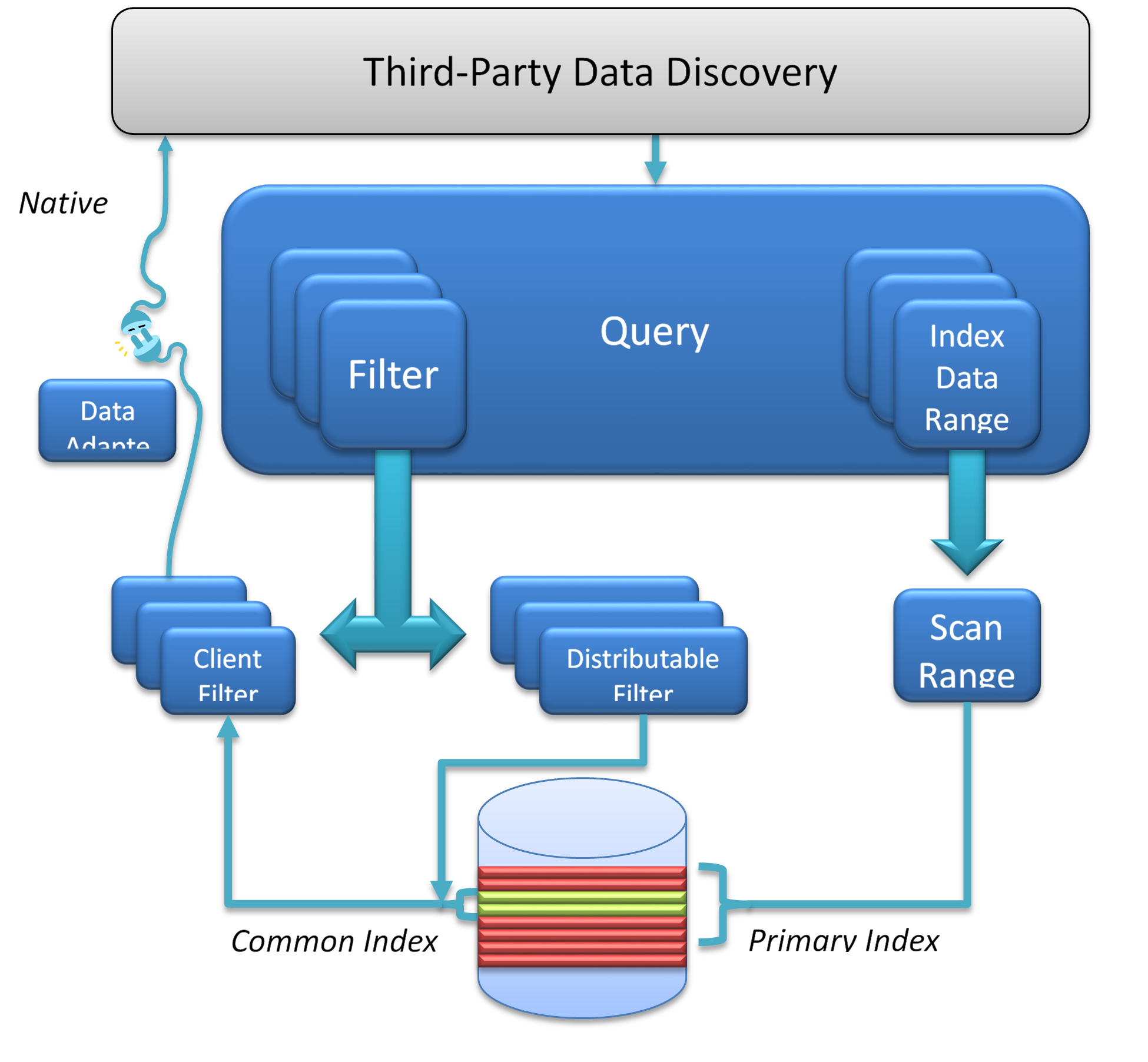
A query in GeoWave currently consists of a set of ranges on the dimensions of the primary index. Up to 3 dimensions (plus temporal optionally) can take advantage of any complex OGC geometry for the query window. For dimensions of 4 or greater the query can only be a set of ranges on each dimension (i.e. hyper-rectangle, etc.).
The query geometry is decomposed by GeoWave into a series of ranges on a one dimensional number line - based on a compact Hilbert space filling curve ordering. These ranges are sent through an Accumulo batch scanner to all the tablet servers. These ranges represent the coarse grain filtering.
At the same time the query geometry has been serialized and sent to custom Accumulo iterators. These iterators then do a second stage filtering on each feature for an exact intersection test. Only if the stored geometry and the query geometry intersect does the processing chain continue.
A second order filter can then be applied - this is used to remove features based on additional attributes - typically time or other feature attributes. These operators can only exclude items from the set defined by the range - they cannot include additional features. Think "AND" operators - not "OR".
A final filter is possible on the client set - after all the returned results have been aggregated together. Currently this is only used for final de-duplication. Whenever possible the distributed filter options should be used - as it splits the work load among all the tablet servers.
Remotes
Remote Commands
Operations to manage a remote store
geowave remote calcstat
NAME
geowave remote calcstat - Calculate a specific statistic in the remote store, given adapter ID and statistic ID
SYNOPSIS
geowave remote calcstat [options] <store name> <adapterId> <statId>
DESCRIPTION
The geowave remote calcstat operator will calculate a specific statistic in the remote store, given adapter ID and statistic ID.
OPTIONS
- --auth
-
The authorizations used for the statistics calculation as a subset of the accumulo user authorization; by default all authorizations are used.
geowave remote clear
NAME
geowave remote clear - Clear ALL data from a GeoWave store and delete tables
SYNOPSIS
geowave remote clear [options] <store name>
DESCRIPTION
The geowave remote clear operator will clear ALL data from a GeoWave store and delete tables
OPTIONS
There are currently no options for this command
geowave remote listadapter
NAME
geowave ingest listadapter - display all adapters in this remote store
SYNOPSIS
geowave ingest listadapter [options] <store name>
DESCRIPTION
The geowave ingest listadapter operator will display all adapters in this remote store.
OPTIONS
There are currently no options for this command
geowave remote listindex
NAME
geowave remote listindex - Display all indices in this remote store
SYNOPSIS
geowave remote listindex [options] <store name>
DESCRIPTION
The geowave remote listindex operator will display all indices in a specific remote store
OPTIONS
There are currently no options for this command
geowave remote liststats
NAME
geowave remote liststats - Print statistics of an existing GeoWave dataset to standard output
SYNOPSIS
geowave remote liststats [options] <store name> [<adapter name>]
DESCRIPTION
The geowave remote liststats operator will print statistics of an existing GeoWave dataset to standard output
OPTIONS --auth The authorizations used for the statistics calculation as a subset of the accumulo user authorization; by default all authorizations are used.
geowave remote recalcstats
NAME
geowave remote recalcstats - Calculate the statistics of an existing GeoWave dataset
SYNOPSIS
geowave remote recalcstats [options] <store name> <adapterId> <statId>
DESCRIPTION
The geowave remote recalcstats operator will calculate the statistics of an existing GeoWave dataset
OPTIONS
- --auth
-
The authorizations used for the statistics calculation as a subset of the accumulo user authorization; by default all authorizations are used.
geowave remote rmstat
NAME
geowave remote rmstat - Remove a statistic from the remote store
SYNOPSIS
geowave remote rmstat [options] <store name> <adapterId> <statId>
DESCRIPTION
The geowave remote rmstat operator will Remove a statistic from the remote store. You will be prompted with "Are you sure?"
OPTIONS --auth::
The authorizations used for the statistics calculation as a subset of the accumulo user authorization; by default all authorizations are used.
Third Party
GeoServer
Geowave supports both raster images and vector data exposed through Geoserver.
WFS-T
Geowave supports WFS-T for vector data by extending GeoTools. After following the deployment steps, Geowave appears as a data store type called 'GeoWave Datastore'.
On the Geowave data store creation tab, the system prompts for the following properties.
| Name | Description | Constraints |
|---|---|---|
zookeeper |
Comma-separated list of Zookeeper host and port. |
Host and port are separated by a colon (host:port). |
instance |
The Accumulo tablet server’s instance name. |
The name matches the one configured in Zookeeper. |
user |
The Accumulo user name. |
The user should have administrative privileges to add and remove authorized visibility constraints. |
password |
Accumulo user’s password. |
|
gwNamespace |
The table namespace associated with this Accumlo data store |
|
Lock Management |
Select one from a list of lock managers. |
Zookeeper is required with a multiple Geoserver architecture. |
Authorization Management Provider |
Select from a list of providers. |
|
Authorization Data URL |
The URL for an external supporting service or configuration file. |
The interpretation of the URL depends on the selected provider. |
Query Index Strategy |
The pluggable query strategy to use for querying geowave tables - a reasonable default will be used if not supplied. |
Transactions
Transactions are initiated through a Transaction operation, containing inserts, updates and deletes to features. WFS-T supports feature locks across multiple requests by using a lock request followed by subsequent use of a provided lock ID. The Geowave implementation supports transaction isolation. Consistency during a commit is not fully supported. Thus, a failure during a commit of a transaction may leave the affected data in an intermediary state. Some deletions, updates or insertions may not be processed in such a case. The client application must implement its own compensation logic upon receiving a commit-time error response. As expected with Accumulo, operations on a single feature instances are atomic.
Inserted features are buffered prior to commit. The features are bulk fed to the data store when the buffer size is exceeded and when the transaction is committed. In support of atomicity and isolation, flushed features, prior to commit, are marked in a transient state, only visible to the controlling transaction. Upon commit, these features are 'unmarked'. The overhead incurred by this operation is avoided by increasing the buffer size to avoid pre-commit flushes.
Lock Management
Lock management supports life-limited locks on feature instances. There are only two supported lock managers: in-memory and Zookeeper. In-memory is suitable for single Geoserver instance installations.
Index Selection
Data written through WFS-T is indexed within a single index. The adapter inspects existing indices, finding one that matches the data requirements. A geo-temporal index is chosen for features with temporal attributes. The adapter creates a geospatial index upon failure of finding a suitable index. A geotemporal index is not created, regardless of the existence of temporal attributes. Currently, geotemporal indices lead to poor performance for queries requesting vectors over large spans of time.
Authorization Management
Authorization Management provides the set of credentials compared against the security labels attached to each cell.
Authorization Management determines the set of authorizations associated with each WFS-T request. The available
Authorization Management strategies are registered through the Server Provider model, within the file
META-INF/services/mil.nga.giat.geowave.vector.auth.AuthorizationFactorySPI.
The provided implementations include the following: . Empty - Each request is processed without additional authorization. . JSON - The requester user name, extracted from the Security Context, is used as a key to find the user’s set of authorizations from a JSON file. The location of the JSON file is determined by the associated Authorization Data URL (e.g. file://opt/config/auth.json). An example of the contents of the JSON file is given below.
{
"authorizationSet": {
"fred" : ["1","2","3"],
"barney" : ["a"]
}
}Fred has three authorization labels. Barney has one.
Visibility Management
Visibility constraints, applied to feature instances during insertions, are ultimately determined in
mil.nga.giat.geowave.store.data.field.FieldWriter, of which there are writers for each supported data type in
Geoserver. By default, the set visibility expression attached to each feature property is empty. Visibility Management
supports selection of a strategy by wrapping each writer to provide visibility. This alleviates the need to extend the
type specific FieldWriters.
The visibility management strategy is registered through the Java Server Provider model, within in the file
META-INF/services/mil.nga.giat.geowave.vector.plugin.visibility.ColumnVisibilityManagement. The only provided
implementation is the JsonDefinitionColumnVisibilityManagement. The implementation expects an property within each
feature instance to contain a JSON string describing how to set the visibility for each property of the feature
instance. This approach allows each instance to determine its own visibility criteria.
Each name/value pair within the JSON structure defines the visibility for the associated feature property with the same
name. In the following example, the geometry property is given a visibility S; the eventName is given a visibility TS.
{ "geometry" : "S", "eventName": "TS" }JSON attributes can be regular expressions, matching more than one feature property name. In the example, all properties
except for those that start with 'geo' have visibility TS.
{ "geo.*" : "S", ".*" : "TS" }The order of the name/value pairs must be considered if one rule is more general than another, as shown in the example.
The rule . matches all properties. The more specific rule geo. must be ordered first.
The system extracts the JSON visibility string from a feature instance property named GEOWAVE_VISIBILITY. Selection
of an alternate property is achieved by setting the associated attribute descriptor 'visibility' to the boolean value TRUE.
Installation from RPM
Overview
There is a public GeoWave RPM Repo available with the following packages.
As you’ll need to coordinate a restart of Accumulo to pick up changes to the GeoWave iterator classes the repos default to
be disabled so you can keep auto updates enabled. When ready to do an update simply add --enablerepo=geowave to your
command. The packages are built for a number of different hadoop distributions (Cloudera, Hortonworks and Apache) the RPMs
have the vendor name embedded as the second portion of the rpm name (geowave-apache-accumulo, geowave-hdp2-accumulo or geowave-cdh5-accumulo)
Examples
# Use GeoWave repo RPM to configure a host and search for GeoWave RPMs to install
# Several of the rpms (accumulo, jetty and tools) are both GeoWave version and vendor version specific
# In the examples below the rpm name geowave-$VERSION-VENDOR_VERSION would be adjusted as needed
rpm -Uvh http://s3.amazonaws.com/geowave-rpms/release/noarch/geowave-repo-1.0-3.noarch.rpm
yum --enablerepo=geowave search geowave-0.9.0-cdh5
# Install GeoWave Accumulo iterator on a host (probably a namenode)
yum --enablerepo=geowave install geowave-0.9.0-cdh5-accumulo
# Update
yum --enablerepo=geowave install geowave-0.9.0-cdh5-*| Name | Description |
|---|---|
geowave-*-accumulo |
Accumulo Components |
geowave-*-core |
Core (home directory and geowave user) |
geowave-*-docs |
Documentation (HTML, PDF and man pages) |
geowave-*-tools |
Command Line Tools (ingest, etc.) |
geowave-*-jetty |
GeoServer components installed into /usr/local/geowave/geoserver and available at http://FQDN:8080/geoserver |
geowave-*-puppet |
Puppet Scripts |
geowave-*-single-host |
All GeoWave Components installed on a single host (sometimes useful for development) |
geowave-repo |
GeoWave RPM Repo config file |
geowave-repo-dev |
GeoWave Development RPM Repo config file |
RPM Installation Notes
RPM names contain the version in the name so support concurrent installations of multiple GeoWave and/or vendor versions. A versioned /usr/local/geowave-$GEOWAVE_VERSION-$VENDOR_VERSION directory is linked to /usr/local/geowave using alternatives ex: /usr/local/geowave → /usr/local/geowave-0.9.0-hdp2 but there could also be another /usr/local/geowave-0.8.9-cdh5 still installed but not the current default.
View geowave-home installed and default using alternatives
alternatives --display geowave-home
geowave-home - status is auto.
link currently points to /usr/local/geowave-0.9.0-hdp2
/usr/local/geowave-0.9.0-hdp2 - priority 90
/usr/local/geowave-0.8.9-cdh5 - priority 89
Current `best' version is /usr/local/geowave-0.9.0-hdp2.geowave-*-accumulo: This RPM will install the GeoWave Accumulo iterator into the local file system and then upload
it into HDFS using the hadoop fs -put command. This means of deployment requires that the RPM is installed on a node that
has the correct binaries and configuration in place to push files to HDFS, like your namenode. We also need to set the ownership
and permissions correctly within HDFS and as such need to execute the script as a user that has superuser permissions in HDFS.
This user varies by Hadoop distribution vendor. If the Accumulo RPM installation fails, check the install log located at
/usr/local/geowave/accumulo/geowave-to-hdfs.log for errors. The script can be re-run manually if there was a problem that
can be corrected like the HDFS service was not started. If a non-default user was used to install Hadoop you can specify a user
that has permissions to upload with the --user argument /usr/local/geowave/accumulo/deploy-to-geowave-to-hdfs.sh --user my-hadoop-user
With the exception of the Accumulo RPM mentioned above there are no restrictions on where you install RPMs. You can install the rest of the RPMs all on a single node for development use or a mix of nodes depending on your cluster configuration.
Maven Repositories
Overview
There are public maven repositories available for both release and snapshot GeoWave artifacts (no transitive dependencies). Automated deployment is available, but requires a S3 access key (typically added to your ~/.m2/settings.xml)
Maven POM fragments
Installation from Source
GeoServer
GeoServer Versions
GeoWave has to be built against specific versions of GeoWave and GeoTools. To see the currently supported versions look at the build matrix section of the .travis.yml file in the root directory of the project. All of the examples below use the variable $BUILD_ARGS to represent your choice of all the dependency versions.
Example build args:
export BUILD_ARGS="-Daccumulo.version=1.6.0 -Dhadoop.version=2.5.0-cdh5.3.0 -Dgeotools.version=13.0 -Dgeoserver.version=2.7.0 -Dvender.version=cdh5 -Daccumulo.api=1.6 -P cloudera"GeoServer Install
First we need to build the GeoServer plugin - from the GeoWave root directory:
mvn package -P geotools-container-singlejar $BUILD_ARGSlet’s assume you have GeoServer deployed in a Tomcat container in /opt/tomcat
cp deploy/target/*-geoserver-singlejar.jar /opt/tomcat/webapps/geoserver/WEB-INF/lib/and re-start Tomcat
Running from EMR
Provisioning
The configuration files needed to use GeoWave from EMR are stored under the deploy/emr/4 directory. EMR expects that all config files are available from S3 so the first step would be to create an S3 bucket and then copy the two scripts into the S3 bucket adjusting the path used in the command as needed.
The command below is an example of using the API to launch an EMR cluster, you could also provide this same information from the console. There are a number of fields that are unique to each deployment most of which you’ll see with a placeholder like YOUR_KEYNAME in the command below. If running from a bash script you can use variable replacement to collect and substitute value such as the number of worker instances. Use the command below as a starting point, it will not work if you try to cut and paste.
Once the process of cluster initialization has started you will see the cluster appear in the EMR console immediately. The GeoWave portion of the process does not occur until the Hadoop and Spark portions of the initializations have completed which takes approximately 4-5 minutes. Once the GeoWave components have been installed there is an optional volume initialization step that will read every block of each volume to clear any initialization flags that may have been set. This option should be used when you want to benchmark an operation but can probably be skipped if you’re primarily interested in quickly setting up a cluster to test some capability.
aws emr create-cluster \
--name "geowave-emr" \
--instance-groups InstanceGroupType=MASTER,InstanceCount=1,InstanceType=m3.xlarge InstanceGroupType=CORE,InstanceCount=${NUM_WORKERS},InstanceType=m3.xlarge \
--ec2-attributes "KeyName=YOUR_KEYNAME,SubnetId=YOUR_SUBNET_ID" \
--region YOUR_REGION \
--release-label emr-4.3.0 \
--applications Name=Ganglia Name=Hadoop Name=Hue Name=Spark \
--use-default-roles \
--no-auto-terminate \
--bootstrap-actions Path=s3://YOUR_S3_BUCKET/emr/4/bootstrap-geowave.sh,Name=Bootstrap_GeoWave_Node \
--tags "Name=geowave-emr-worker"Connecting
To connect to the cluster you’d use ssh to connect to the console and another ssh connection setting up a SOCKS proxy to connect via a web browser to the various web consoles. The key you’d use in both cases would be the one you specified in the ec2-attributes KeyName portion of the command.
-
Example SSH Console connection:
ssh -i YOUR_KEYFILE ec2-user@MASTER_FQDN -
Example SOCKS Proxy connection:
ssh -i YOUR_KEYFILE -ND 5556 ec2-user@MASTER_FQDN
After establishing the SOCKS proxy you’d then configure your browser to use the port you specified. A more detailed explanation can be found in the AWS docs: https://docs.aws.amazon.com/ElasticMapReduce/latest/ManagementGuide/emr-ssh-tunnel.html
Links
After setting up a SOCKS proxy to the master node you should be able to connect to any of the following web consoles hosted from the cluster. The name of the master node can be found in the description of the EMR job in the AWS console. Example: Master public DNS: ec2-52-91-31-196.compute-1.amazonaws.com
-
Accumulo: http://MASTER_FQDN:50095
-
Ganglia Monitoring: http://MASTER_FQDN/ganglia/
-
GeoWave GeoServer: http://MASTER_FQDN:8000/geoserver/
-
HDFS: http://MASTER_FQDN:50070
-
YARN: http://MASTER_FQDN:8088
Configuration
After the cluster has finished initializing you should be able to ssh into the master node and perform the final bits of project specific GeoWave configuration. The root password for Accumulo is set at the top of the bootstrap-geowave.sh script. You’d want to log into Accumulo and perform steps listed in the Accumulo Configuration section of the documentation. The latest iterator built for Apache Hadoop will have been uploaded into HDFS but no user accounts, namespaces or VFS contexts will have been configured. All of these are described with examples in both the GeoWave and Accumulo documentation.
Accumulo Configuration
Overview
The two high level tasks to configure Accumulo for use with GeoWave are to ensure the memory allocations for the master and tablet server processes are adequate and to add the GeoWave Accumulo iterator to a classloader. The iterator is a rather large file so ensure the Accumulo Master process has at least 512m of heap space and the Tablet Server processes have at least 1g of heap space.
The recommended Accumulo configuration for GeoWave requires several manual configuration steps but isolates the GeoWave libraries in application specific classpath(s) reducing the possibility of dependency conflict issues. A single user for all of geowave data or a user per data type are two of the many local configuration options just ensure each namespace containing GeoWave tables is configured to pick up the geowave-accumulo.jar.
Procedure
-
Create a user and namespace
-
Grant the user ownership permissions on all tables created within the application namespace
-
Create an application or data set specific classpath
-
Configure all tables within the namespace to use the application classpath
accumulo shell -u root
createuser geowave (1)
createnamespace geowave
grant NameSpace.CREATE_TABLE -ns geowave -u geowave (2)
config -s general.vfs.context.classpath.geowave=hdfs://NAME_NODE_FQDN:8020/ACCUMULO_ROOT/classpath/geowave/VERSION_AND_VENDOR_VERSION/[^.].*.jar (3)
config -ns geowave -s table.classpath.context=geowave (4)
exit| 1 | You’ll be prompted for a password |
| 2 | Ensure the user has ownership of all tables created within the namespace |
| 3 | The Accumulo root path in HDFS varies between hadoop vendors. Cloudera is /accumulo and Hortonworks is /apps/accumulo |
| 4 | Link the namespace with the application classpath, adjust the labels as needed if you’ve used different user or application names |
These manual configuration steps have to be performed before attempting to create GeoWave index tables. After the initial configuration you may elect to do further user and namespace creation and configuring to provide isolation between groups and data sets.
Managing
After installing a number of different iterators you may want to figure out which iterators have been configured.
# Print all configuration and grep for line containing vfs.context configuration and also show the following line
accumulo shell -u root -p ROOT_PWD -e "config -np" | grep -A 1 general.vfs.context.classpathYou will get back a listing of context classpath override configurations which map the application or user context you configured to a specific iterator jar in HDFS.
Versioning
It’s of critical importance to ensure that the various GeoWave components are all the same version and that your client is of the same version that was used to write the data.
Basic
The RPM packaged version of GeoWave puts a timestamp in the name so it’s pretty easy to verify that you have a matched set of RPMs installed. After an update of the components you must restart Accumulo to get vfs to download the new versions and this should keep everything synched.
[spohnae@c1-master ~]$ rpm -qa | grep geowave
geowave-0.9.0-hdp2-core-0.9.0-201602012009.noarch
geowave-0.9.0-hdp2-jetty-0.9.0-201602012009.noarch
geowave-0.9.0-hdp2-accumulo-0.9.0-201602012009.noarch
geowave-0.9.0-hdp2-tools-0.9.0-201602012009.noarchAdvanced
When GeoWave tables are first accessed on a tablet server the vfs classpath tells Accumulo where to download the jar file from HDFS. The jar file is copied into the local /tmp directory (the default general.vfs.cache.dir setting anyway) and loaded onto the classpath. If there is ever doubt as to if these versions match you can use the commands below from a tablet server node to verify the version of this artifact.
sudo -u hdfs hadoop fs -cat /accumulo/classpath/geowave/geowave-accumulo-build.properties | grep scm.revision | sed s/project.scm.revision=(1)| 1 | The root directory of Accumulo in various distributions can vary, check with hadoop fs -ls / first to ensure you have the correct initial path |
sudo find /tmp -name "*geowave-accumulo.jar" -exec unzip -p {} build.properties \; | grep scm.revision | sed s/project.scm.revision=//[spohnae@c1-node-03 ~]$ sudo -u hdfs hadoop fs -cat /ACCUMULO_ROOT/classpath/geowave/VERSION_AND_VENDOR_VERSION/geowave-accumulo-build.properties | grep scm.revision | sed s/project.scm.revision=//
294ffb267e6691de3b9edc80e312bf5af7b2d23f (1)
[spohnae@c1-node-03 ~]$ sudo find /tmp -name "*geowave-accumulo.jar" -exec unzip -p {} build.properties \; | grep scm.revision | sed s/project.scm.revision=//
294ffb267e6691de3b9edc80e312bf5af7b2d23f (2)
294ffb267e6691de3b9edc80e312bf5af7b2d23f (2)
25cf0f895bd0318ce4071a4680d6dd85e0b34f6b| 1 | This is the version loaded into hdfs and should be present on all tablet servers once Accumulo has been restarted |
| 2 | The find command will probably locate a number of different versions depending on how often you clean out /tmp. |
There may be multiple versions copies present, one per JVM, the error scenario is when a tablet server is missing the correct iterator jar.
Building
GeoWave will shortly be available in maven central (for tagged releases), but until then - or to get the latest features - building GeoWave from source is the best bet.
Application Dependencies
This ultra quickstart assumes you have installed and configured:
-
Java JDK (>= 1.7). The OracleJDK is the most thoroughly tested, but there are no known issues with OpenJDK.
-
Maven >= 3.2.1
-
Apache Accumulo version 1.5 or greater is required. 1.5.0, 1.5.1, and 1.6.0 have all been tested.
-
Apache Hadoop versions 1.x and 2.x should all work. The software has specifically been run on:
-
Cloudera CDH4 and CDH5 (MR1)
-
MapReduce 1 with the new API (org.apache.hadoop.mapreduce.*) is used. Testing is underway against YARN / MR2 and seems to be positive, but well, it’s still underway.
-
Java Advanced Imaging and Java Image I/O are also both required to be installed on the GeoServer instance(s) as well as on the Accumulo nodes. The Accumulo support is only required for certain functions (distributed rendering) - so this may be skipped in some cases.
Maven dependencies
Required repositories not in Maven Central have been added to the parent POM. Specifically the cloudera and opengeo repos.
Build Process
Checkout GeoWave, set your preferred dependencies as build arguments and then run maven install.
export BUILD_ARGS="-Daccumulo.version=1.6.0-cdh5.1.4 -Dhadoop.version=2.6.0-cdh5.4.0 -Dgeotools.version=13.0 -Dgeoserver.version=2.7.0 -Dvendor.version=cdh5 -Daccumulo.api=1.6 -P cloudera" (1)
git clone https://github.com/ngageoint/geowave.git (2)
cd geowave
mvn install $BUILD_ARGS (3)| 1 | Examples of current build args can be seen in the top level .travis.yml file in the env/matrix section |
| 2 | If you don’t need the complete history and want to speed up the clone you can limit the depth of your checkout with --depth NUM_COMMITS |
| 3 | You can speed up the build by skipping tests by adding -Dfindbugs.skip=true -DskipFormat=true -DskipITs=true -DskipTests=true |
|
Integration Tests: Windows Integration tests are currently not working on Windows out of the box. If you install cygwin and set the environmental variable CYGPATH to the location of the cygpath binary provided by cygwin then this should work. |
Docker Build Process
We have preliminary support for building both the GeoWave jar artifacts and RPMs from Docker containers. This capability is useful for a number of different situations:
-
Jenkins build workers can run Docker on a variety of host operating systems and build for others
-
Anyone running Docker will be able to duplicate our build and packaging environments
-
Will allow us to build on existing container clusters instead of single purpose build VMs
If building artifacts using Docker containers interests you check out the README in deploy/packaging/docker
Jace JNI Proxies
Using Jace, we are able to create JNI proxy classes for GeoWave which can be used in C/C++ applications.
Boost is required when using the Jace bindings.
Prepackaged Source and Binaries
There is a public GeoWave RPM Repo where you can download a tarball for the GeoWave Jace bindings for your desired platform. If your platform is not available, there is a source tarball which can be used in conjunction with CMake to build the GeoWave Jace bindings for your desired platform.
Generate Proxies and Build from Source
If you want, you can generate and build the Jace proxies yourself.
Step 1 - Checkout Jace and GeoWave
First, we need to clone Jace and GeoWave.
$ git clone git@github.com:jwomeara/jace.git
$ git clone git@github.com:ngageoint/geowave.gitNote: We are using a non-standard Jace implementation.
Step 2 - Install Jace
First, we need to install Jace v1.3.0. This is the software which is used to generate the C++ proxy classes.
$ cd jace
$ git checkout tags/v1.3.0
$ mvn clean install -DsourcesStep 3 - Generate GeoWave Jace Proxies
Here, we will specify a Maven profile which specifies that we are building jace proxies.
$ cd geowave
$ mvn clean package -pl deploy -am -P generate-geowave-jace -DskipTestsThis generates the source and header files required to build GeoWave. To build the library, simply run cmake, followed by make.
Note: To build static libraries use -DBUILD_SHARED_LIBS=OFF, otherwise use -DBUILD_SHARED_LIBS=ON
Mapnik Plugin Configuration
Mapnik
Mapnik is an open source toolkit for developing mapping applications. GeoWave is supported as a plugin for Mapnik for reading vector data from Accumulo.
PDAL Plugin Configuration
PDAL
The Point Data Abstraction Library PDAL is a BSD licensed library for translating and manipulating point cloud data of various formats. GeoWave is supported as a plugin for PDAL for both reading and writing data to Accumulo.
Note: These instructions assume that you are using prepackaged binaries.
Configure CMake for PDAL
To configure PDAL to run with GeoWave, there are a few CMake options which need to be configured. While some of the options (namely the JAVA options) may configure automatically, some will need to be set manually. Refer to the table below to get an idea for how these options would be configured on Ubuntu 14.04 LTS.
| Option | Value | Automatically Configured? |
|---|---|---|
BUILD_PLUGIN_GEOWAVE |
ON |
|
BUILD_GEOWAVE_TESTS |
ON |
|
GEOWAVE_RUNTIME_JAR |
/path/to/geowave/geowave-runtime.jar |
|
GEOWAVE_INCLUDE_DIR |
/path/to/geowave/include |
|
GEOWAVE_LIBRARY |
/path/to/geowave/libgeowave.so |
|
JAVA_AWT_INCLUDE_PATH |
/usr/lib/jvm/java-8-oracle/include |
X |
JAVA_INCLUDE_PATH |
/usr/lib/jvm/java-8-oracle/include |
X |
JAVA_INCLUDE_PATH2 |
/usr/lib/jvm/java-8-oracle/include/linux |
X |
JAVA_AWT_LIBRARY |
/usr/lib/jvm/java-8-oracle/jre/lib/amd64/libjawt.so |
X |
JAVA_JVM_LIBRARY |
/usr/lib/jvm/java-8-oracle/jre/lib/amd64/server/libjvm.so |
X |
Note: As Boost is a PDAL dependency, it should already be included.
Puppet
Overview
A GeoWave Puppet module has been provided as part of both the tar.gz archive bundle and as an RPM. This module can be used to install the various GeoWave services onto separate nodes in a cluster or all onto a single node for development.
There are a couple of different RPM repo settings that may need setting. As the repo is disabled by default to avoid picking up new Accumulo iterator jars without coordinating a service restart you’ll have to enable and then disable in consecutive Puppet runs to do the initial install.
Options
- geowave_version
-
The desired version of GeoWave to install, ex: '0.9.1'. We support concurrent installs but only one will be active at a time.
- hadoop_vendor_version
-
The Hadoop framework vendor and version against which GeoWave was built. Examples would be cdh5 or hdp2, check the available packages site for currently supported hadoop distributions.
- install_accumulo
-
Install the GeoWave Accumulo Iterator on this node and upload it into HDFS. This node must have a working HDFS client.
- install_app
-
Install the GeoWave ingest utility on this node. This node must have a working HDFS client.
- install_app_server
-
Install Jetty with Geoserver and GeoWave plugin on this node.
- http_port
-
The port on which the Jetty application server will run - defaults to 8080.
- repo_base_url
-
Used with the optional geowave::repo class to point the local package management system at a source for GeoWave RPMs. The default location is http://s3.amazonaws.com/geowave-rpms/release/noarch/
- repo_enabled
-
To pick up an updated Accumulo iterator you’ll need to restart the Accumulo service. As we don’t want to pick up new RPMs with something like a yum-cron job without coordinating a restart so the repo is disabled by default.
- repo_refresh_md
-
The number of seconds before checking for new RPMs. On a production system the default of every 6 hours should be sufficient but you can lower this down to 0 for a development system on which you wish to pick up new packages as soon as they are made available.
Examples
Development
Install everything on a one node development system, use the GeoWave Development RPM Repo and force a check for new RPMs with every pull (don’t use cached metadata)
# Dev VM
class { 'geowave::repo':
repo_enabled => 1,
repo_refresh_md => 0,
} ->
class { 'geowave':
geowave_version => '0.9.0',
hadoop_vendor_version => 'cdh5',
install_accumulo => true,
install_app => true,
install_app_server => true,
}Clustered
Run the application server on a different node, use a locally maintained rpm repo vs. the one available on the Internet and run the app server on an alternate port so as not to conflict with another service running on that host.
# Master Node
node 'c1-master' {
class { 'geowave::repo':
repo_base_url => 'http://my-local-rpm-repo/geowave-rpms/dev/noarch/',
repo_enabled => 1,
} ->
class { 'geowave':
geowave_version => '0.9.0',
hadoop_vendor_version => 'cdh5',
install_accumulo => true,
install_app => true,
}
}
# App server node
node 'c1-app-01' {
class { 'geowave::repo':
repo_base_url => 'http://my-local-rpm-repo/geowave-rpms/dev/noarch/',
repo_enabled => 1,
} ->
class { 'geowave':
geowave_version => '0.9.0',
hadoop_vendor_version => 'cdh5',
install_app_server => true,
http_port => '8888',
}
}Puppet script management
As mentioned in the overview the scripts are available from within the GeoWave source tar bundle (Search for gz to filter the list) or you could use the RPM package to install and pick up future updates on your puppet server.
Source Archive
Unzip the source archive, locate puppet-scripts.tar.gz and manage the scripts yourself on your Puppet Server
RPM
There’s a bit of a boostrap issue when first configuring the Puppet server to use the geowave puppet RPM as yum won’t know about the rpm repo and the GeoWave Repo Puppet class hasn’t been installed yet. There is an RPM available that will set up the yum repo config after which you should install geowave-cdh-puppet manually and proceed to configure GeoWave on the rest of the cluster using Puppet.
rpm -Uvh http://s3.amazonaws.com/geowave-rpms/release/noarch/geowave-repo-1.0-3.noarch.rpm
yum --enablerepo=geowave install geowave-puppetDocumentation
Overview
The documentation is writen in AsciiDoc which is a plain-text markup format that can be created using any text editor and read “as-is”, or rendered to several other formats like HTML, PDF or EPUB.
Helpful Links:
Ordering
All of the content stored in the docs/content directory of this project will be rendered into a single web page with
an auto-generated table of contents and a PDF. The order in which the pages appear is determined by the sort order of
the file names given to the ASCIIDOC files in the docs/content directory so a numeric prefix has been given to each
file. Gaps can be left in between the numbers (only the sort order is important) to allow for future edits without having
to renumber other documents that will appear after the new content.
Preview
To preview markup as HTML before making a commit there are plugins available various text editors and IDEs that can be used while editing. If your preferred text editor has no plugin available there’s a Firefox AsciiDoc Plugin available which allows for previewing with a quick refresh of the browser.
Transformation
To preview the entire finished page web page or see the generated PDF you’ll need to run the transformation process.
cd geowave
mvn -P docs -pl docs install (1)| 1 | -pl docs = Process only the docs module. Skips the javadoc generation step. |
The source documents will be transformed and will be available for inspection in the geowave/target/site/ directory.
Site
To build all the content used for the GeoWave website use the following command. The
entire site, including both docs and javadocs, will be available for inspection in the geowave/target/site/ directory.
cd geowave
mvn -P docs install